
























Littelfuse products are engineered to withstand the harshest underground and surface mining environments to improve safety and reduce downtime.


Neutral-Grounding Resistors (NGRs) and Monitors
■ Meet 2021 CE Code requirements
■ Detect shorted NGR and monitor neutral-to-ground continuity


Motor and Pump Protection
■ Extends motor life and reduces downtime
■ Provides metering, datalogging, and fault diagnostics


Ground-Fault Protection
■ Advanced filtering eliminates nuisance tripping and detects ground faults early
■ Reliable, sensitive ground-fault detection down to 0 Hz on systems with variable-frequency drives on resistance-grounded systems




Industrial and Power
Semiconductor Fuses
■ Extremely current-limiting
■ Short circuit protection


■ Combination ground-fault and ground-check monitoring to ensure proper equipment grounding
■ Our relays protect equipment at the end of some of the longest mining cable runs in the world

Surge Protection
■ Clamps and withstands highenergy transients to prevent equipment damage and downtime
■ Thermal protection eliminates catastrophic failure

Arc-Flash Protection
■ Reduces arc-flash energy and risk of injury or equipment
■ Redundant solid-state trip circuit provides fast and fail-safe operation even from black start

Industrial Shock Protection
■ Human-level GFCI protection for equipment up to 600 V and 100 A
■ Commonly used on submersible pumps, AC welders, and portable loads in wet areas and confined spaces




















shayna@delcommunications.com
Welcome to the Critical Minerals Review, a biannual digital publication which is your go-to source for essential insights and updates in the dynamic world of critical minerals. As the global demand for these resources continues to soar, our mission remains steadfast: to keep you informed on the most pressing developments and strategic shifts in this crucial sector.
In this issue, we delve into feature stories that underscore the evolving landscape of critical minerals and their profound implications for Canada and beyond. On page 16, we begin our regular feature which highlights Canada’s 2024 update to its critical minerals list, adding three more: high-purity iron, phosphorus, and silicon, for a total of 34 vital resources. This expansion reflects not only the increasing recognition of the strategic importance of these minerals, but also the evolving nature of the global economy. As technology advances and new applications emerge, the criteria for what constitutes a critical mineral are shifting. This feature will be one you will see regularly in the next few issues as we go through the A to Z in Canada’s critical minerals list and how these precious minerals are used in everyday life.
On page 26, we take a closer look at Nova Scotia’s burgeoning critical minerals sector. The province, long known for its rich geological diversity, is now emerging as a key player in the critical minerals arena. We explore Nova Scotia’s unique mineral deposits, the advancements in exploration and extraction technologies, and the strategic initiatives being implemented to harness these resources responsibly. This report sheds light on how regional developments are contributing to the broader national and global efforts to secure a stable supply of critical minerals. Nova Scotia’s progress is a testament to the untapped potential that lies within Canada’s diverse mineral resources.
We also examine the nuanced relationship between

Canada’s critical minerals and reserves. While the country is recognized for its substantial mineral resources, the distinction between available reserves and those deemed critical is becoming increasingly significant. This analysis provides a comprehensive look at the current state of Canada’s mineral reserves, the challenges faced in maintaining and expanding these reserves, and the strategic measures needed to ensure a sustainable supply chain. As global competition intensifies, understanding this dynamic is crucial for positioning Canada as a leader in the critical minerals sector.
As we navigate through these stories, it is clear that the critical minerals landscape is undergoing rapid transformation. The interplay between policy, technology, and market demand is reshaping how we approach the exploration, extraction, and utilization of these essential resources. This first edition of the Critical Minerals Review aims to provide you with a thorough understanding of these developments, offering valuable perspectives and insights that are critical for making informed decisions in this everevolving field.
We hope you find this issue both informative and engaging. We also invite you to visit our official website, www.criticalmineralsreview.com, which highlights more critical minerals news across Canada and the world.
Us at DEL Communications Inc. would also like to extend a huge thank you to Natural Resources Canada for updating their Critical Minerals Maple Leaf graphic and allowing us to use it to adorn the cover. We are humbled and are forever grateful.
As always, we welcome your feedback and look forward to continuing our exploration of the critical minerals sector together.
Thank you for your continued support and readership. We hope you enjoy this issue! 8
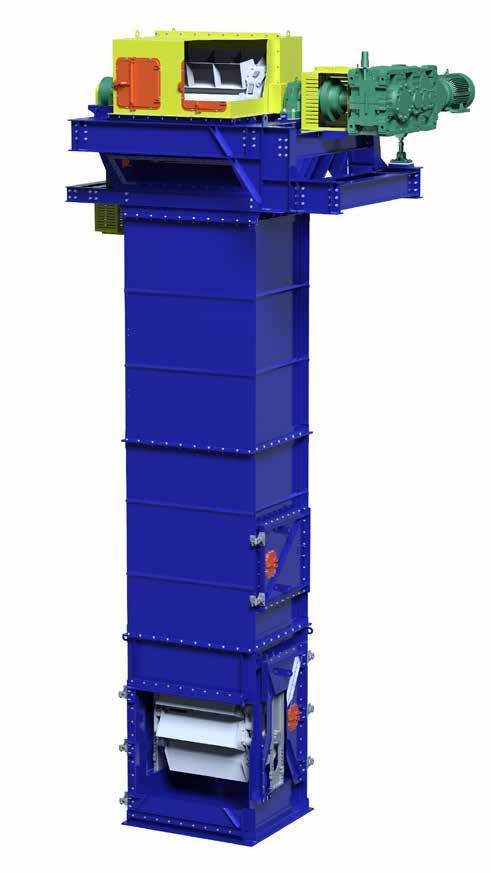

When it comes to mining and exploration for minerals, there are few places more exciting than Ontario. Our government has a sound plan to achieve our goal of making our province the top mining jurisdiction in the world. Ontario is a leading global producer of gold, and we have the potential to become a powerhouse in the critical minerals space.
The world is racing to secure reliable sources of critical minerals for the electric vehicle revolution and to develop the technologies of tomorrow. however, nations that do not share our world-class human rights, environmental standards, and labour practices have a dangerous stranglehold on the supply of the minerals we need. Recent events around the world have highlighted weaknesses in global supply chains and an overreliance on others for what we have here in Ontario.
We do not want to build electric vehicles with nickel mined from countries that burn coal and dump the mine waste into the ocean. We have what the world needs right here in Northern Ontario – the minerals, expertise, and talent to become the foundation of the growing supply chain for critical minerals and clean technologies in North America and beyond.
That’s why we launched our Critical Minerals Strategy that includes $55 million in targeted investments in everything from exploration to innovation. Ontario’s Critical Minerals Strategy is laying the foundation for us to build an integrated supply chain for electric vehicles and other clean technologies by connecting mineral producers in the north with the manufacturing might of the south. Our made-in-Ontario supply chain starts with mining, and mining starts with exploration. That’s why our government is investing $35 million in the Ontario Junior Exploration Program to help junior companies find the mines of the future.
Our investments don’t stop with exploration; we are also investing in the downstream industries, like processing, to ensure we fill supply chain gaps. Our Critical Minerals Innovation fund does just that – it helps organizations solve modern mining and supply chain challenges by leveraging Ontario’s highly educated and experienced workers. And, as announced in Ontario’s 2024 Budget, we are investing an additional $15 million over three years in the fund to support research, development,
and commercialization of technologies, processes, and solutions for critical minerals. We have an obligation to produce the fuel of the future here in Ontario because we have the best miners in the world.
We know that our government must do more than invest to ensure we maximize the opportunity we have in the mineral exploration and mining sector. That’s why our government passed the Building More Mines Act – to cut the red tape that was holding the sector back. The Act ensures government can operate at the pace of business without sacrificing our world-class environmental protections or how we consult with Indigenous communities. This is an important piece of legislation that will help develop the mineral deposits in our province while bringing prosperity to everyone in Ontario, especially northern and Indigenous communities.
Developing the resources in the Ring of f ire is another key to building a stronger mining sector. At PDAC this past March, I signed a Community Development Agreement with Marten falls f irst Nation and Webequie f irst Nation. The agreement will support shovel-ready infrastructure projects, like new training facilities, that will create more local jobs and upskill individuals to prepare them for meaningful careers. Most importantly, the agreement is designed to improve the well-being and readiness of f irst Nations partners to participate fully in future economic development, including building roads and mineral development.
Mining is a pillar of our economy because it provides the materials we need for other sectors to thrive, such as the growing electric vehicle manufacturing sector. Ontario also benefits from being one of the largest producers of gold in the world, which is an important store of value during these times of economic uncertainty. Our government continues to demonstrate our commitment to the mining sector because we have an obligation to the people of Ontario to build a stronger economy. We know that this sector must thrive for us to accomplish that goal and create a better future for everyone in Ontario, especially for those of us who live in the north. I know we still have more work ahead of us, but I am excited to work with industry and Indigenous partners to get it done. 8

CMI-EV 1700
Battery Powered Mancarrier
There is no electric vehicle transition without critical minerals.
CMI professionals came up with a tailored solution!
•
•
• Regenerative Braking System + Opportunity Charging
• 48 Volt Lithium Ion Battery System A/C Drive Motor
• Mine Proven Chassis & Drive Train
• On-Board Multi-Voltage Charging System (110V-230V)
• Certified Modular R.O.P.S. System
• Zero Maintenance Self-Protecting Battery Management System
• 100% Electrical Disconnect with Master Switch
• 5 Year Battery Warranty (3 Year Unlimited Replacement)
• Additional Safety Options Available Upon Request
• Regenerative Braking System + Opportunity Charging
• Mine Proven Chassis & Drive Train
• Certified Modular R.O.P.S. System
• Customized drive profile to meet customers unique requirements
• 100% Electrical Disconnect with Master Switch
• Additional Safety Options Available Upon Request
• Customized drive profile to meet customers unique requirements
CMI designs, builds, and integrates
and industrial solutions
of experience and processes give
CMI
Our expertise, years of experience and processes give us a unique perspective of our customers’ requirements.
CMI delivers tailored solutions by asking the right questions and understanding the individual needs of
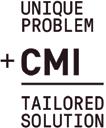

Nova Scotia has an abundance of natural resources and we have the ability to develop them sustainably and inclusively.
We have many of the critical minerals that our modern world depends on for renewable energy, food production, defense applications, and healthcare. We also have strong environmental regulations to make sure our economy and environment are both sustainable.
This gives Nova Scotia a significant advantage and many opportunities as the world moves to a net-zero economy. By tapping into our vast resources of critical minerals, we can play a central role in this global transition while creating a more resilient and prosperous economy for generations of Nova Scotians.

To advance this effort, Nova Scotia released its Critical Minerals Strategy in March 2024. It includes a list of 16 critical minerals that are found in Nova Scotia. These minerals are in global demand, can help with climate change goals, and present strategic opportunities for the Province.
The strategy is supporting research and the development of a robust critical minerals industry that will create new job opportunities, attract investment, build value chains, and drive sustainable economic growth.
We invite potential partners to contact us and learn more about the critical mineral opportunities that Nova Scotia has to offer. Together, we can help make our province, our country, and our world more sustainable. 8




For over 40 years, the largest mining companies in the world have put their confidence in Richwood’s innovative material handling solutions.
When it comes to solving problems with dust and material containment, Richwood achieves success with engineered passive dust containment systems. Application-specific solutions optimize efficiency through sealed and protected load zones without the need for vacuums, filters or other additional equipment. The reduced wear and tear on equipment and controlled dust and spillage create a safer and more productive work environment. Worry free load zones are designed and built by Richwood every day.
What would it mean for your productivity if dust and spillage issues were eliminated? Contact Richwood today for a review of your application.




ALX Resources Corp. (ALX) is based in vancouver, B.C. and its common shares are listed on the TSX venture Exchange under the symbol “AL”; on the frankfurt Stock Exchange under the symbol “6LLN”; and in the United States OTC market under the symbol “ALXEf ”.
ALX’s mandate is to provide shareholders with multiple opportunities for discovery by exploring a portfolio of prospective mineral properties primarily in Canada, which include uranium, lithium, nickel, copper, and gold projects. The company uses the latest exploration technologies and holds interests in over 240,000 hectares of prospective lands in Saskatchewan, a stable jurisdiction (ranked number two in the world by the fraser Institute’s 2023 Investment Attractive Index) that hosts the highest-grade uranium mines in the world, a producing gold mine, diamond deposits, and decades of historical production from base metals mines.
ALX’s uranium holdings in the Athabasca Basin region of northern Saskatchewan include 100 per cent interests in the following projects:
• Gibbons Creek Uranium Project (currently the subject of an option earn-in agreement with Trinex Minerals Ltd. of Perth, Australia, who can earn up to a 75 per cent interest in two stages)
• Javelin Uranium Project • McKenzie Lake Uranium Project
• Sabre Uranium Project • Bradley Uranium Project
The company also owns the following Athabasca Basin area projects:

• A 60 per cent interest in the Carpenter Lake Uranium Project, currently the subject of an option transaction with greenridge Exploration Inc. (CSE: gXP);
• A 40 per cent interest in the Black Lake Uranium Project (a joint venture with Uranium Energy Corporation and Orano Canada Inc.); and
• A 20 per cent interest in the Hook-Carter Uranium Project, with Denison Mines Corp. (TSX: DML, 80 per cent interest) as operator of exploration since 2016. hook-Carter is located within the uranium-rich Patterson Lake Corridor, which hosts f ission Uranium’s Triple R deposit, Nexgen’s Arrow deposit, and other important uranium occurrences on neighbouring properties. hook-Carter is currently the subject of an amended property agreement with Denison that would increase ALX’s interest from 20 per cent to 25 per cent after fulfilling certain financial and exploration expenditure conditions.
ALX owns 100 per cent interests in the f irebird Nickel Project, f lying vee Nickel/gold, Blackbird and Sceptre gold projects, and can earn up to an 80 per cent interest in the Alligator Lake gold Project, all located in northern Saskatchewan, Canada. ALX owns, or can earn, up to 100 per cent interests in the Electra Nickel Project and the Cannon Copper Project located in historic mining districts of Ontario, Canada, and in the v ixen gold Project (now under option to f irst Mining gold Corp., who can earn up to a 100 per cent interest in two stages).
ALX owns a 50 per cent interest in eight lithium exploration properties staked in 2022-2023 collectively known as the h ydra Lithium Project, located in the James Bay region of northern Québec, Canada, and 100 per cent interests in the Anchor Lithium Project in Nova Scotia, Canada. They also have 100 per cent interests in the Crystal Lithium Project and the Reindeer Lithium Project, both located in northern Saskatchewan, Canada. 8


n 2024, Canada added three new critical minerals to their list to include high-Purity Iron, Phosphorus, and Silicon metal. As Canada’s industrial landscape evolves, the role of critical minerals in shaping the future of technology, infrastructure, and sustainability becomes increasingly prominent. Over the coming issues of the Critical Minerals Review, we’ll delve into the multifaceted uses of these minerals, spotlighting how they drive innovation and support various sectors.
In this first installment, we explore the diverse applications of aluminum, antimony, bismuth, cesium, chromium, and cobalt—six critical minerals that are integral to both the Canadian industry and global advancements.
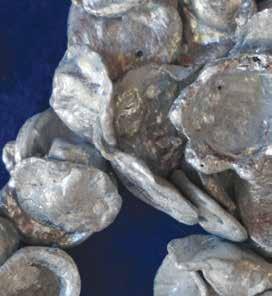
Aluminum is a versatile metal with applications spanning several industries.
Aluminum is a versatile metal with applications spanning several industries. Its lightweight and corrosion-resistant properties make it a preferred material in the transportation sector. In automotive and aerospace industries, aluminum reduces fuel consumption and enhances efficiency. For example, the use of aluminum in aircraft structures not only decreases weight but also improves fuel efficiency and payload capacity. Similarly, in automobiles, aluminum parts contribute to lighter vehicles that consume less fuel and emit fewer greenhouse gases.
In construction, aluminum’s strength and malleability are exploited in the production of windows, doors, and roofing.
The metal’s resistance to corrosion and ease of fabrication make it ideal for structural components and cladding, contributing to durable and sustainable building solutions.
Aluminum’s packaging applications are equally significant. Its impermeability and ability to preserve contents make aluminum foil and containers indispensable in food and beverage packaging, pharmaceuticals, and cosmetics. This not only extends shelf life, but also maintains the quality of the products.
Electrical applications also benefit from aluminum’s excellent conductivity and lightweight nature. Aluminum conductors in power lines and cables help reduce energy losses during transmission, while their light weight simplifies installation and reduces infrastructure costs.
furthermore, aluminum’s aesthetic appeal and functional properties find a place in consumer goods such as cookware, electronics, and sports equipment. Its corrosion resistance and durability make it a popular choice for a range of consumer products, enhancing their lifespan and performance.
AnTimony: The fire-resisTAnT elemenT
Antimony, though less visible in everyday products, plays a crucial role in various applications. In alloys, it is a key hardening agent, especially in lead-acid batteries, wh ere it enhances the mechanical strength and durability of battery plates.
In fire retardants, antimony compounds are utilized to inhibit
Antimony, though less visible in everyday products, plays a crucial role in various applications.

flame spread in plastics, textiles, and other materials. This application is vital for improving safety in a wide range of consumer and industrial products.
Antimony’s role in semiconductors is significant as well. Used as a dopant in the production of diodes and infrared detectors, antimony helps in the creation of electronic components essential for modern technology.
In pigments, antimony compounds such as antimony trioxide, are used to create white colours in paints, ceramics, and glass, contributing to the aesthetic and functional properties of these products.
historically, antimony compounds were employed in medicine, but due to their toxicity, their use has largely been replaced by safer alternatives. Nonetheless, antimony remains important in military applications, including ammunition and flame-proofing materials.

Bismuth is a unique mineral with several distinct uses. In pharmaceuticals, bismuth compounds like bismuth subsalicylate are used to treat gastrointestinal issues by providing relief and protecting the stomach lining.

In cosmetics, bismuth oxychloride is valued for its pearlescent qualities. This shimmering effect enhances the texture and appearance of products like eyeshadows and face powders.
bismuth melts at low temperatures to trigger water release, aiding in fire suppression.
Moreover, bismuth-based compounds are used in thermoelectric materials, which convert heat into electrical energy. This technology is applied in thermoelectric generators and cooling devices, contributing to energy efficiency and sustainability.
Cesium is known for its high-precision applications. In atomic clocks, cesium provides highly accurate timekeeping essential for scientific research, telecommunications, and g PS systems.
Cesium-133 atoms emit electromagnetic radiation at a precise frequency, allowing for accurate time measurement.

In spacecraft propulsion, cesium-based ion thrusters offer an efficient means of propulsion by accelerating cesium ions using electric fields. This technology supports long-term space missions and satellite operations due to its efficiency and longevity.
Metallurgy benefits from bismuth as well, with its use in fusible and low-melting point alloys. These alloys are crucial in applications such as soldering, plumbing, and casting.
In the nuclear industry, bismuth serves as a neutron absorber in some reactor types and provides radiation shielding. This application is critical for managing radiation exposure and enhancing reactor safety.
Bismuth compounds are also utilized in fire detection and suppression systems. for example, in sprinkler systems, Bismuth is a unique mineral with several distinct uses.
Cesium is also utilized in chemical synthesis processes, where compounds like cesium carbonate act as powerful bases in organic reactions. Additionally, cesium-based photoelectric cells and medical imaging devices, such as X-ray scintillators, convert light into electrical signals and improve imaging techniques.
In the oil and gas industry, cesium formate solutions are used as high-density drilling fluids, enhancing wellbore stability and drilling efficiency in challenging conditions.
f inally, cesium vapour thermionic generators explore the use of cesium’s thermionic emission properties to convert heat into electricity, potentially powering spacecraft and portable devices.

Chromium’s most prominent use is in stainless-steel production, where it imparts corrosion resistance, hardness, and strength.
Chromium’s most prominent use is in stainless-steel production, where it imparts corrosion resistance, hardness, and strength. Stainless steel, containing up to 20 per cent chromium, is integral to construction, automotive parts, kitchenware, and industrial equipment.
Chrome plating is another significant application, providing a decorative and protective layer on metal surfaces. This process is used extensively in automotive parts, bathroom fixtures, and consumer goods.
Chromium also finds use as an alloying agent in various metal alloys, enhancing their strength and heat resistance. These alloys are used in aerospace, marine, and chemical processing industries, where durability and performance are critical.
In chemical production, chromium compounds are used in pigments, dyes, and corrosion inhibitors. The metal’s high melting point and thermal stability make it suitable for refractory materials used in high-temperature applications such as kiln bricks and furnace linings.
Aerospace and defense applications also benefit from chromium’s high strength-to-weight ratio and corrosion resistance, making it ideal for components like aircraft parts and armour plating.
Lastly, chromium supplements are used in dietary supplements and pharmaceuticals to regulate blood sugar levels and improve insulin sensitivity in diabetic patients.
Cobalt’s versatility spans multiple industries. In alloys, cobalt enhances the strength, corrosion resistance, and heat resistance of materials used in aerospace components, gas turbine engines, and medical implants.

Cobalt’s versatility spans multiple industries, such as chemical processes, magnets, pigments and dyes, medical devices, and more.
Batteries rely on cobalt for improving energy density, stability, and longevity in lithium-ion cells used in smartphones, laptops, and electric vehicles. Despite efforts to reduce cobalt use due to ethical concerns, it remains a crucial component in battery technology.
Cobalt also serves as a catalyst in chemical processes such as petroleum refining and hydrogenation. Its role in facilitating reactions and improving selectivity is vital for various industrial applications.
In magnets, cobalt is a key element in high-strength permanent magnets used in electric motors, wind turbines, and MRI machines.
Pigments and dyes containing cobalt provide vibrant colours in ceramics, glass, and paints. Additionally, cobaltchromium alloys are used in medical devices like hip and knee replacements due to their biocompatibility and mechanical properties.
f inally, cobalt-60, a radioactive isotope, is used in cancer treatment via radiation therapy, targeting cancerous cells while minimizing damage to surrounding healthy tissues.
In this edition, we’ve scratched the surface of how these critical minerals contribute to various sectors, driving innovation and supporting modern technologies. As we continue to explore other minerals in upcoming issues, we’ll uncover more about their impact on Canada’s economy and global advancements. Stay tuned for deeper insights into the essential elements shaping our world. 8




















































































































































































































By Lynnel Reinson Communications
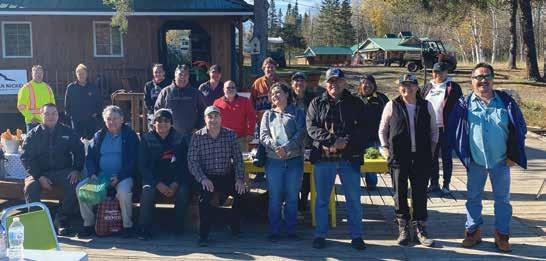
Tartisan Nickel Corp. (CSE:TN, OTC:TTSRf, f SE:8TA) is a Canadian mining exploration and development company focused on battery metals headquartered in Toronto, Ont. Tartisan’s flagship project is the whollyowned Kenbridge Nickel-Copper Deposit, located in the Kenora mining district of northwestern Ontario. The company’s portfolio also includes two polymetallic projects in Ontario, the Sill Lake LeadSilver Project and Turtle Pond Night Danger Nickel Project. Tartisan Nickel is poised to help deliver the critical metals necessary for the North American supply chain and the global transition to clean energy.
President and CEO Mark Appleby describes how the company saw the opportunity in 2018 to reposition Tartisan upon acquiring their flagship Kenbridge Project as part of the Canadian Arrow Mines Limited deal.
“We saw the need for battery metals and the looming adaptation of electric vehicles,” said Appleby to the Northern Miner.
Since acquiring the Kenbridge Project, Tartisan Nickel Corp. has directed its focus towards the three critical metals— nickel, copper, and cobalt—in advancing work on their Kenbridge Project.
Tartisan Nickel Corp. has updated the mineral resource estimate and completed a preliminary economic assessment and is now looking to get permits in place and further defining and expanding the mineral resource, which is open at depth and along strike. Definition drilling to bring the inferred ore deposits into the indicated category is a near-term goal as onemillion tonnes plus could move into the indicated resource calculation.
Tartisan benefits from existing infrastructure such as the 622 metre, three-compartment shaft sunk by falconbridge in 1954 that remains in good condition. Access is gamechanging when attempting to develop a mining project; atop the benefit of this existing shaft, the Kenbridge road
is being refurbished and developed to allow all-season access to the main deposit.
Dean MacEachern, Tartisan’s geological advisor for the Kenbridge project, was a part of both falconbridge and Canadian Arrow Mines during the periods they each held the asset, prior to the global adoption of large batteries and electric vehicles that began driving the significantly increased demand for nickel.
“At the top of the Kenbridge deposit, it’s more disseminated and as you go deeper into the zones, it gets more semi-massive and massive. It gets narrower but the grade gets better,” said MacEachern to the Northern Miner.
This variable grading in the deposit will allow Tartisan to more readily accommodate price variations for nickel, and with the pre-existing shaft, MacEachern says that the expected capital expenditure will be substantially lower than other similar projects.
“It’s under $140 million to get started. That compares with a lot of large lowgrade deposits that will take $2 billion to get going,” said MacEachern.
The asset has undergone extensive drilling and surveying since 1937 with 100,000-plus metres of surface and underground drilling conducted, including 11,700 metres drilled by Tartisan in 2021. The results of the drilling are a measured and indicated resource of 117 million pounds of nickel
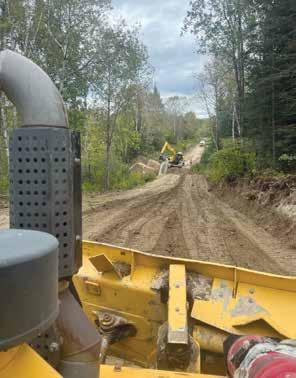
(Ni), 66 million pounds of copper (Cu), and a million pounds of cobalt (Co).
Necessary next steps for the project are refurbishing and upgrading the road to the main deposit; Tartisan has retained Northwest Solutions Inc. to build out this all-season access to the Kenbridge project. Northwest Solutions is an Ontario-based services company offering forestry, mining, and environmental services, as well as training, project management support, and communications consulting services (Newsfile). A family ownedand-operated business since 2014, Northwest Solutions has designed an all-season access solution and now provides support to Tartisan Nickel, including permitting and project management assistance. Brandi Shorthouse is the road project’s finance and communications manager, and Kevin Shorthouse is the road project’s design and road permitting project manager, bringing unique expertise to the endeavour, as well as their connection to the local area, which Tartisan CEO, Mark Appleby believes will provide tremendous value to the Kenbridge project.
When attempting to refurbish and put in an all-season road, as well as
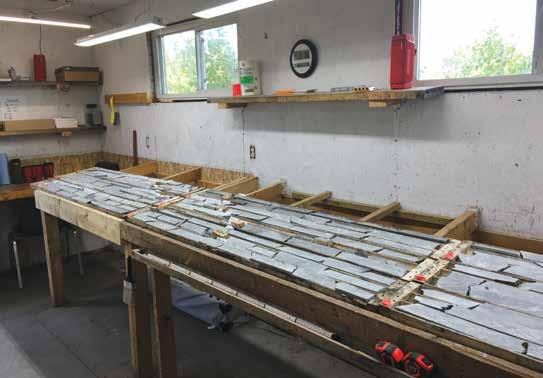
potentially building out the larger project as a whole, local community and f irst Nations support are key to the success of any project. Appleby first addressed how much he and the company value the relationships that they have built in the area. In support of these relationships, Tartisan Nickel named greg Edwards as the overall project manager for Kenbridge and as the company’s f irst Nations liaison. Edwards has been consistent in his desire to work with, build, and support good relationships with the f irst Nations near the project: Naotkamegwanning f irst Nation, formerly known as the Whitefish Bay First Nation, Northwest Angle #33 f irst Nation, and Northwest Angle #37 f irst Nation. Since 2007, the company has been engaged with Treaty #3 and recognized the f irst Nations’ rights to lands, seeking their consent, agreement, and continuing to engage all First Nations in our area of influence.
As part of Tartisan’s ongoing practices and ongoing community relations, the Kenbridge project received a blessing in an October 2021 ceremony conducted by an elder from one of the f irst Nations. With current road upgrades underway, Tartisan will be a part of the next ceremonial blessing occurring this
autumn. Working with f irst Nations and engaging local companies for the Tartisan project, Tartisan intends to continue advancing project goals and hiring local f irst Nations personnel whenever possible. Looking at 2024-25, Appleby says that there are multiple, on-going initiatives coming together. Alignment with Indigenous communities, summation of the baseline studies for project permitting, and the commencement of all-season access construction.
“These, combined with new geophysical initiatives and a drill program, will lead to expansion of the Kenbridge Resource Estimate and support a substantially higher enterprise value,” said Appleby. “Our efforts should prove to have a profound impact on increasing shareholder value and make for exciting times over the next 24 months.”
https://www.northernminer.com/news/ jv-article-tartisan-nickel-outlines-lowcost-underground-nickel-sulphide-mine-atflagship-kenbridge-project/1003846160/ https://www.newsfilecorp.com/ release/203101/Tartisan-Nickel-Corp.Retains-Northwest-Solutions-Inc.-toComplete-the-Kenbridge-Nickel-ProjectAllSeason-Access-Road-Names- gregoryEdwards-as- f irst-Nations-Liaison. 8


CFrom early-stage exploration to environmental reclamation, the mineral industry generates economic activity across the country.
anada’s history includes over a century of evolution within our mineral exploration, development, and mining industry.
We have honed on-the-ground reconnaissance and remote-sensing skills used to identify prospective areas and new deposit discoveries, and Canadian companies are at the forefront in research and development of new extraction, processing, and reclamation techniques. With this, Canada has built up a continuum of skills and businesses making us a global industry leader.
This evolution started here at home – in a country fortunate to have such a wide range of geological environments that host the mineral and metal deposits we rely upon as a modern society. from early-stage exploration to environmental reclamation, the mineral industry generates economic activity across the
Don’t miss the world’s premier mineral exploration and mining convention
2-5 5
PROSPECTORS & DEVELOPERS ASSOCIATION OF CANADA

Up to 30,0 00 attendees 700+ hours of programming
1,100+ exhibitors Delegates from 130+ countries
Meet investors & senior executives Unrivaled networking pdac.ca/convention | Toronto, Canada



RESOURCES RESERVES
country, and Canadians should take pride in how the sector continues to evolve responsible and sustainable best practices.
Looking back, Canada has ranked as high as second in the world for nickel production, and today we remain a top 10 producer of nickel, gold, iron ore, and zinc, with Canadian companies representing some of the lowest carbon-intensity producers of minerals and metals across the globe. These achievements come in part from extensive reliance on hydroelectric and nuclear energy in mineral extraction and processing.
Looking ahead, Canada will have to continue to expand our energy generation capacity and our electrical grids will need to integrate new technology to support a growing population and industrial base into the future. This is true even before we consider decarbonizing our energy and transportation infrastructure, implementing a critical minerals strategy, or aiming to become a responsible supplier of critical minerals for other nations. This challenge will require a multitude of industries to establish (in most cases) completely new supply chains that rely on sourcing new mineral deposits, as much as
recycling and improved efficiencies.
Some estimates suggest that meeting ambitious global decarbonization targets will demand more copper by 2035 than has ever been mined to date, and that we will need to see six new large mines brought into production each year through 2050, and beyond. how are we doing against these measures? how much copper do we really have in the ground and how much do we extract each year? Are we discovering more than we mine? And do we have enough to build out future Canadian industries?
We will attempt to answer some of these questions.
To understand Canada’s copper potential, the difference between a mineral resource and mineral reserve must be noted. The Canadian Institute of Mining (CIM) defines a mineral resource as “a concentration or occurrence of solid material of economic interest in or on the earth’s crust in such form, grade or quality and quantity that there are reasonable prospects for eventual economic extraction.” Only after more detailed scoping work that includes economic, geotechnical, engineering, and other factors is complete can a mineral resource be ‘upgraded’ to
Source: S&P, NRCan
a mineral reserve – the next step to becoming a source of new production. There is a contrast in trends as copper resources climbed roughly 35 per cent over the last eight years, while reserves have fallen over 20 per cent in the same time period. This means that we have found more copper, yet the amount that could reach production in the next decade has fallen substantially.
Like reserves, copper production in Canada is down over 20 per cent since 2014, despite the fact the metal’s price has risen nearly 100 per cent over its low point in 2015. We show copper here as an example, but the trends are similar when looking at nickel or zinc, while production of lithium in Canada remains limited to a single mine in 2024. Although the largest industrial mobilization in history may be imminent, we are very quickly losing our capacity to produce the raw inputs needed to drive this transition.
fortunately, we have seen Canada’s copper resources climbing in recent years, coinciding with a notable rise in metal pricing, a growing global awareness of critical minerals, and the launch of Canada’s Critical Mineral Exploration Tax Credit (CMETC). These drivers have sparked domestic
exploration spending, and are an affirmation that incentives can have a real impact on the ground.
how do we see more resources upgraded to reserves and then build more mines to reverse the trend of falling production in Canada?
A few of the efforts PDAC has been asking our federal government to take on include:
• Expand eligibility so companies can use flow-through funds towards scoping and assessment work, and see more mineral resources converted into reserves.
• Boost the level of public geoscience funding, increase accessibility of geoscience modelling and research, and integrate across government decision-making.
• Ensure tax credits and incentives like

the Clean Technology Manufacturing Investment Tax Credit are applicable to Canadian polymetallic mineral deposits and essential mining activities.
• Commit to major infrastructure builds in rail, roads, hydroelectric, and alternative energy sources to bring minerals closer to markets.
• Help ‘close the loop’ on minerals mined, processed, and refined in Canada by supporting new domestic processing, recycling capabilities, and capacities.
We have seen our capacity to produce minerals like copper, nickel, and zinc slowly decline in Canada, and we are not finding new mineable deposits – or building mines fast enough – to offset this. We need support from all Canadians across the country to reverse these trends – we must build

more mines to reduce our reliance on foreign mineral inputs, increase our transmission capacity, and deliver responsibly-sourced minerals from Canada to global markets. Without this broad support, the mineral industry will continue to flounder, despite the development of targeted strategies and incentives.
PDAC will continue to champion this message, and we call on governments across the country to ensure it resonates with Canadians, so we can work towards a common goal.
©2024 Prospectors & Developers Association of Canada. All Rights Reserved.
This article was originally published by the Prospectors and Developers Association of Canada (PDAC) in the summer 2024 issue of CORE Magazine 8
Sleipner E Series dollies bring the wheeled advantage your mining operation has been looking for. More working hours, longer undercarriage life, and fewer on-site repairs – the Sleipner E Series dollies will elevate your operation with higher productivity and sustainability.
Reduce equipment travel time up to 85% and increase excavator productivity by up to 12-20%
Sustainability
Reduce life cycle costs by up to 10–18% with fewer spare parts for maintenance and lower fuel consumption.
Maintanence
Save on undercarriage maintenance by up to 50%.

By Mick O’Neill, M.Sc., P.Geo.,Industry Liaison Geologist
The Province of Nova Scotia has a key role to play in Canada’s critical mineral supply chain, through exploration, mining, processing, manufacturing, and recycling, and in support of the province as it moves toward a lowcarbon economy and a goal of netzero greenhouse gas emissions by 2050. Nova Scotia, though small in comparison to other provinces and territories, has a diverse geologic history, representing most of the Phanerozoic Eon.
Nova Scotia is a past producer of many critical minerals including copper, zinc, antimony, tin, and tungsten demonstrating the opportunity to discover and develop many other critical mineral deposits across the province.
In addition to its rich geology and mining history, the province has available many excellent online resources for companies and prospectors to plan exploration work in Nova Scotia, including NovaScan, the Nova Scotia g eoscience Maps and Publications Database, and NOvAROC, a web-based application for the acquisition and maintenance of mineral claims in the province. Other information can be found at the g eoscience and Mines Branch website, including the Mineral Occurrence Database, the Abandoned Mine Openings Database, g eoscience Atlas, and the Drillhole Database.
Nova Scotia’s Department of Natural Resources and Renewables has developed a list of 16 critical minerals,
outlined in Nova Scotia’s Critical Minerals Strategy. Using the four criteria identified in the strategy, minerals containing the following elements have been deemed critical: antimony, cobalt, copper, graphite, germanium, gallium, indium, lithium, manganese, molybdenum, niobium, rare earth elements (REE), tantalum, tin, tungsten, and zinc. A summary of critical mineral prospects and occurrences is shown in f igure 1, highlighting the potential for Nova Scotia to contribute critical minerals to the global supply chain. The list is under review and an updated list will be published later this year.
Some key areas of Nova Scotia’s critical mineral potential are highlighted in the recent article, Developing Canada’s critical mineral supply chain in Nova Scotia, with details on five properties: Brazil Lake Lithium Project, Coxheath Copper-Molybdenum porphyryepithermal system, Scotia Mine ZincLead Mississippi valley-type deposit, East Kemptville Tin-Indium pastproducing mine, and the frenchvale flake graphite property (2023 NI 43-101 report).
West g ore, located in central Nova Scotia, was the only antimony mine in Nova Scotia, and contained significant concentrations of gold and silver. It was mined from 1883 to 1917, with the ore occurring as lenses of auriferous stibnite in fissure veins that occupy northwest and southeast faults. A minor anticlinal fold, on the east limb of the West g ore anticline, has some
controlling aspect of the ore deposition and plunge of the ore shoot. Detailed information on the property can be found in the 2022 Battery Elements Corporation’s NI 43-101 Technical Report.
There are numerous anomalous cobalt mineral occurrences, geochemical anomalies, and alteration zones associated with the CobequidChedabucto fault Zone (CCf Z; f igure 1), a 300-kilometre-long crustal fault system within the Cobequid highlands of northern mainland Nova Scotia, which is recognized as part of an Iron Oxide-Copper- g old mineralized system. Examples of occurrences with highly anomalous cobalt concentrations include Sunny Brae, Specular Iron Mines, Mount Thom, and Bass River. There are also numerous cobalt occurrences worth investigating outside of the CCf Z, such as sites in Oceanview, Coxheath, and Nictaux falls.
In Nova Scotia, most of the known manganese occurrences/deposits are associated with replacement or veintype processes of hypogene origin. The main historic manganese deposits are in western Nova Scotia at New Ross and Nicholsville, characterized by infilling of fault zones in granite and gabbro, respectively.
The largest manganese deposit in Nova Scotia occurs at New Ross, associated with the South Mountain Batholith, the largest composite batholith exposed
in the Appalachians. The deposit was discovered in 1891, and was mined at two sites, the Cain and Riddle Mine, and the Dean and Chapter Mine. Approximate production for both mines totalled 3,000 tons of 50 to 60 per cent Mn over the mine life (intermittent between 1890s to the mid-1930s).
The New Ross and Nicholsville manganese prospects are augmented by the widespread (1700-kilometre contact) g oldenville- h alifax transition zone. This set of reactive strata between the carbon-rich halifax g roup and the siliceous g oldenville g roup has never hosted a manganese mine but is likely the best source rock for future exploration. The g oldenville- h alifax transition zone is well documented through geophysical surveys and represents a widespread and continuous stratigraphic body. The transition zone is commonly thin, but often occurs in thick folded sequences and bifurcated, intercalated strata that are more amenable to exploitation.
Rare earth element (REE) mineralization mainly occurs in the Debert Lake area, in northern mainland Nova Scotia. The occurrence is hosted in a three-kilometre-long contact zone, where felsic volcanics and volcaniclastic rocks were intruded by high-level felsic plutonic rocks (approximately 350 Ma). Most of the REEs discovered occur in felsic to mafic volcanic rocks of the Byers Brook formation, near the contact with the underlying granite. The REEbearing minerals include fergusonite, chevkinite, allanite, monazite, and yttrialite. A metasomatic-hydrothermal vein model is proposed for the mineralization. from the samples analyzed to date, heavy REEs tend to dominate relative to light REEs, which

is significant, as heavy REEs are of greater economic value.
Many of Nova Scotia’s saddle-reef gold deposits in the Cambro-Ordovician Meguma Supergroup contain appreciable amounts of scheelite. Two historic properties were mined with tungsten being the primary commodity, and gold secondary. The Stillwater Mine, to the west of the recently mined Touqouy Mine (Au; St Barbara Limited), was the province’s largest tungsten mine (mined from 1911 to 1919). The Indian Path Mine, in southwest Nova Scotia, was the second-most productive mine (mined sporadically from 1868 to 1900 for gold; 1926 to 1943 for tungsten). Cowan Mill Pond, Kempt Snare Lake, and Long Lake are other occurrences in Nova Scotia with strong tungsten potential. Many of these occurrences are hosted in greisen, bordering the contact zones of the Meguma Terrane with the South Mountain Batholith, or Musquodoboit Batholith.
There are other Nova Scotia critical minerals not discussed in this article, and discussed in Developing Canada’s critical mineral supply chain in Nova Scotia. Brazil Lake and Lower Caledonia have tantalumniobium-bearing pegmatites, while the South Mountain Batholith has associated mineralized areas of indium and molybdenum (e.g., East Kemptville and New Ross). Gallium and germanium are associated with numerous zinc deposits in the province.
With Nova Scotia’s abundant natural resources, strong environmental principles, skilled labour, strategic location, strong business and academic communities, and favourable geology and location, the province is well-positioned to be a key player in the critical mineral sector, which will also create exciting opportunities for Nova Scotians. 8

Enhance copper production by up to 20% from low-grade sulfide ores with pH7 Technologies’ innovative upgrade to the existing heap leaching process—elevating efficiency and profitability.
As the world moves towards green energy to meet ambitious net-zero targets by 2050, the demand for copper—a critical metal for energy transition—is constantly increasing. However, the supply of copper is becoming more limited. Most of the easily accessible high-grade copper (oxide ore) has already been mined, and the grade of copper in global mines is steadily decreasing. Currently, over 80% of the world’s copper comes from sulfide ores, which cannot be extracted using the current heap-leaching process. Processing sulfide ores requires comminution (i.e. crushing and grinding), concentration, shipping, and smelting, leading to high costs, a significant environmental footprint, and limits on extraction to ores above a certain grade (i.e. cut-off grade). This leaves nearly half of the copper trapped in low-grade ores, making it uneconomical to process using traditional methods.
The concentration process of sulfide ores would result in high energy consumption, wastewater production, and CO2 emissions, which are impacting the mine’s production capacity due to increasingly stringent governmental regulations.
Copper mining contributes to 4.1 tonnes of carbon emissions and 61 kg of SOX and NOX for every tonne of copper produced. In Canada alone, copper mining is responsible for 2.17 million tonnes of CO2 annually, wasting over 40 million cubic meters of water and consuming 7 million MWh of energy.
Recognizing these challenges, pH7 Technologies has developed a breakthrough in copper extraction, a proprietary closed-loop electrochemical process. This innovative method enables mines to use the current heap leaching process to extract copper from lowgrade sulfide ore and that would otherwise end up in waste rock on mine sites. The pH7 process can increase copper production by up to 50% while producing green hydrogen as a by-product. This process will reduce costs, increase revenue opportunities, and minimize environmental impact while producing green hydrogen that can be a great clean energy source for mine operations and machinery.

In pH7 process, the initial target is lower than cut-off grade sulfide ore. Using the existing heap leaching pads, the crushed rock is placed on the pads, where a proprietary solution circulates, oxidizes the copper and dissolves it into the lixiviant (i.e. leaching solution). An innovative electrolyzer is applied to regenerate the chemistry while producing hydrogen as a by-product, which can be utilized as fuel. This process is scalable and has the potential to replace the current copper supply chain, which involves expensive comminution, concentration, and overseas smelting.
pH7 Technologies has already commercialized a similar technology in the platinum group metals (PGM) sector, working with major industry players like BASF, Johnson Matthey, and Mitsubishi International Corporation. Now, the same innovative spirit is transforming the copper mining industry, offering a sustainable, cost-effective solution for the future.

1.
• Increased revenue by up to 50% through access to low-grade copper, translating to 80,000 additional tonnes of copper in Canada alone.
• Generation of 50 kg of hydrogen per ton of copper on-site, reducing energy costs.
• Reduced energy consumption by 6.85 MWH per ton of copper (Excluding utilization of produced hydrogen), lowering overall operation costs.
• Elimination of overseas smelting and transportation, further cutting expenses.
• Saving over 85 cubic meters of freshwater and eliminating over 75 cubic meters of wastewater per ton of copper.
• Reducing carbon emissions by 4.1 tons of CO2e per ton of copper.
• Shortening the time to market by producing copper cathode on-site, allowing direct shipping to customers.
• Helping mines meet environmental regulations and reducing operational costs.
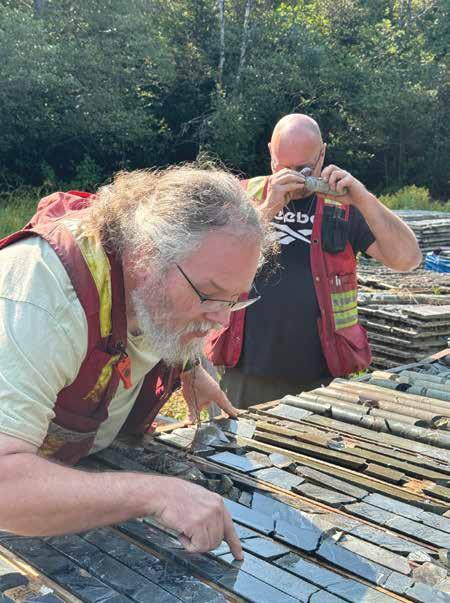
ushered in a new era for Canstar Resources
(TSX-V: ROX). With a January financing led by a group of U.S. investors, new management reinitiated district-scale exploration on its flagship projects: g olden Baie—with high-grade gold and antimony showings up to 74 per cent Sb in bedrock—and Buchans-Mary March, high-grade polymetallic v MS occurrences near the historic pastproducing Buchans Mine, one of the world’s richest base metals deposits.
“We believe that the world is on the cusp of a commodities supercycle and Canstar is the ideal platform from which to capitalize on a generational
and a new interpretation of the polymetallic Buchans River formation bring critical minerals potential
opportunity in mining,” says CEO Juan Carlos giron, Jr. “We were impressed by the local technical team, a distinguished board of directors, cornerstone shareholders Eric Sprott & Altius Minerals Corp., and exploration projects in highly prospective geological settings and a world-class mining district.”
Since then, Canstar has developed a new geological model and priority exploration targets, including investigating the high-grade antimony potential near the past-producing Beaver Brook Antimony Mine.
Antimony is of special importance to national security and defense manufacturing. Production has been
dominated by China and Russia, while Canada has had minimal domestic production in recent years, and the U.S. none, relying heavily on Chinese imports. Prices are projected to continue rising in line with geopolitical tensions over trade, Taiwan, and the war in Ukraine, having already doubled by the summer of 2024.
Canstar also staked an additional 1,100 ha. of prospective gold and antimony claims at g olden Baie and 325 ha. of prospective land south of the historic Buchans Mining Camp. The company is positioned for growth with renewed investor interest, aiming to capitalize on historically low asset prices and expand its project portfolio into 2025.

golden BAie: 549 squAre kilomeTres of highly prospeCTive lAnd wiTh highgrAde AnTimony showings
g olden Baie has a similar geological structure to Newfound g old’s Queensway Project, and exhibits geological similarities to significant gold producers, such as the fosterville Mine in the Bendigo Zone of Australia’s Victorian Goldfields, which hosts multiple gold deposits greater than 5 Moz.
Anomalous results include over 315 bedrock samples with more than 1 g/t and up to 4,485 g/t Au, several float rock samples with 289 g/t and 197 g/t Au, and till samples with up to 1,049 gold grains (809 pristine). Diamond drilling yielded 9.6 g/t Au over 7.6 m and 20.6 g/t Au over 3.5 m. Yet g olden Baie remains underexplored with many exciting targets.
Antimony is a pathfinder in gold exploration on this structure. Antimony targets on g olden Baie are less than 90 kilometres from the Chinese-owned Beaver Brook Antimony Mine, currently under care and maintenance, which hosted a 2.2-million-tonne deposit grading 3.99 per cent Sb at 1.5 per cent
cutoff and was considered the one of the world’s largest antimony deposits outside of China. Two prospects on Canstar’s project feature bedrock and channel samples assaying between 20.4 per cent and 74.4 per cent Sb metal content. historical drilling intersected 30.6 per cent Sb over 1 m.
BuChAns- mAry mArCh: ComBined 99 squAre kilomeTres of prospeCTive ground for CriTiCAl minerAls neAr The hisToriC BuChAns mine wiTh A glenCore Jv
The Buchans Mine has a rich history, having produced 16M tonnes at 1.33 per cent Cu, 7.56 per cent Pb, 14.51 per cent Zn, 1.37 g/t Au, and 1.26 g/t Ag. The Buchans River formation, the host unit for these deposits, underlies Canstar’s main Buchans claim at depth, and the largely shallow nature of historic drilling implies the property is underexplored. Canstar has identified a two-kilometrelong conductor anomaly in this host unit just one-and-a-half kilometres south of the historic mine.
Mary March, a joint venture with g lencore, sits along Buchans’ Roberts Arm Belt 25 kilometres east of the
Drill core from the top of the high-grade massive sulphide at Mary March. Grey sulphide has squeezed into gaps in the overlying black basalt; top row assayed 0.36 m at 0.24 per cent Cu, 6.37 per cent Pb, 46.40 per cent Zn, 15.5 g/t Au, 140 g/t Ag. The honey-coloured sphalerite in the middle row assayed 0.48 m at 0.25 per cent Cu, 6.03 per cent Pb, 42.70 per cent Zn, 20.9 g/t Au, 168 g/t Ag.
Buchans Mine. Canstar trenching discovered a debris flow setting similar to the Buchans deposits with massive sulphide clasts assaying up to 5.7 per cent Cu, 1.6 per cent Pb, 1.8 per cent Zn, 1.2 g/t Au, and 29.4 g/t Ag. historical drilling intersected a massive sulphide fragment with 9.63 m at 0.64 per cent Cu, 1.8 per cent Pb, 10.1 per cent Zn, 4.2 g/t Au, and 122 g/t Ag. This is a large mineralized system with a proven massive sulphide lens and potential for more.
Canstar’s previous efforts have mostly focused on the gold potential at g olden Baie. But with the West’s renewed focus on critical minerals, not only for the energy transition but also for these materials’ importance to defense and national security amid what analysts call a Second Cold War, Canstar plans to focus increasingly on its critical minerals potential along with gold.
Please visit canstarresources.com for more information. Paul Ténière, M.Sc., P.Geo., a Qualified Person as defined in NI 43-101, approved all technical data. 8

Québec’s energy industry isn’t all about hydropower: it’s also hard at work developing other renewable energies like wind power.
Québec is positioning itself as a dynamic, essential, and innovative player in the green economy thanks to its many strategic industries. They play a pivotal role in global value chains, making a major contribution to the sustainable energy transition and helping to secure our economic partners’ supply chains.
The CriTiCAl And sTrATegiC minerAls seCTor
Québec’s subsoil abounds in 28 critical and strategic minerals (CSMs), including lithium, graphite, nickel, and rare earths. These elements play a central role in the development of green technologies, particularly in manufacturing batteries for electric vehicles and energy storage. high-purity iron and environmentally friendly green aluminum are also important when it comes to decarbonizing our economies.
“Québec hold an enviable position in
the global value chain for critical and strategic minerals. These materials are vital, not only for building more environmentally friendly means of transportation, but also for ensuring Québec’s energy independence. We have moved from an oil-based economy to one based on mineral resources,” noted Jean- françois Béland, Investissement Québec’s vicepresident of strategic industries.
Québec, an acknowledged green steel champion, has some of the world’s richest and purest iron deposits, particularly in the Labrador Trough region. These deposits are characterized by iron contents that often exceed 60 per cent, significantly higher than the world average, and make it possible to cut CO 2 emissions by 50 to 85 per cent compared to traditional steel.

The industry also uses advanced and innovative extraction and processing methods.
“Steel production traditionally requires a lot of energy, which is often generated from fossil sources. In Québec, hydropower—and in the near future, green hydrogen—allow us to make steel with a much smaller carbon footprint,” Béland stated.
This industry also includes green aluminum. One of the most remarkable features of the aluminum produced in Québec is its small environmental footprint compared to that of other regions, due mostly to the use of hydropower. Using clean energy makes Québec aluminum greener than aluminum produced with more polluting energies such as coal or natural gas.
“Québec’s green steel and green aluminum sectors boast several world leaders, including Arcelor Mittal, Québec Iron Ore, Rio Tinto Alcan, Alcoa,

and Aluminerie Alouette,” said Béland. “These companies are constantly innovating to fine-tune their production processes in order to cut costs, minimize their environmental impact and develop new alloys with improved properties.”
The green energy seCTor Québec’s energy industry isn’t all about hydropower: it’s also hard at work developing other renewable energies like wind power, with calls for tenders issued to add thousands of MW of power



by 2029. These initiatives are part of a global drive to meet the increasing demand for electricity and promote a sustainable economy.
And while solar energy accounts for
only a modest share of the current energy mix, its role is certain to increase in the years ahead on the strength of Québec’s considerable solar potential.
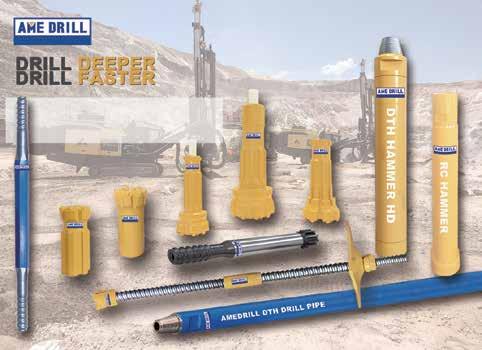
“The battery industry is booming thanks to a series of strategic initiatives and significant investments. Several plants are under construction, notably in Bécancour, which has become the battery industry’s epicentre,” noted Beland. “People from all over the world are taking an interest in its development.”
The industry’s appeal is further strengthened by Québec’s abundant natural resources and ability to produce clean energy, giving it a competitive edge not only in attracting investment but also in serving the North American electric vehicle market.
In conclusion, backed by its advances in green technologies and ongoing commitment to an economy fuelled by clean resources, Québec is ideally positioned to play a key role in the global energy transition. 8


PCL has supported the North American mining sector for decades. We service the entire lifecycle of the mine site, from greenfield construction to sustaining capital projects, expansions, continuous maintenance, and turnarounds. With our experience in mining infrastructure, utilities, power and water, heavy material handling, milling, mineral processing, and metallurgy we deliver mining projects with safety and quality at their foundation.


Since the 1970s, we were living in a world where we thought that all we had to do to improve our standards of living was to have our goods manufactured in low-manpowercost countries. Then we realized that in a chain of manufacturing process, rupture of the weakest link makes the chain collapse, and the longer the chain, the higher the risk of rupture, especially if this link is located far away. Add the awareness about the carbon footprint of shipping, the ES g culture, the electrification of everything, and geopolitical turmoil, and here we are facing the perfect wake-up call. Manufacturing for the developed world shall be brought back close to market in dependable jurisdictions. Et voilà, the largest industrialization in North America since the Second World War is on its way!
When China joined the WTO in 2001 they understood the need to control access to mineral and metals to secure their manufacturing and export-driven economic model. Then it became the mining behemoth who now destabilizes the occidental industrial foundations. All this led to the realization of the criticality of a domestic mineral supply chain. Not because mining is of exceptional profitability, but because unsecured access to resources threatens the entire economic system.
quéBeC , A CriTiCAl plAyer Québec, with its diverse geology, is broadly endowed with mineral resources. With access to abundant
clean energy, extensive infrastructure, skilled labour, and proximity to North American manufacturing hubs, Québec has everything it needs to be a mining powerhouse. Then, add the political will, since both provincial and federal governments addressed the supply chain criticality by providing massive incentives to build a robust battery manufacturing ecosystem.
Not so long ago, the Canadian automotive industry was facing existential threats due to southward migration of the U.S. base manufacturing and the conversion to E v manufacturing was seen as its salvation board. Announcements of billions of dollars of investments in battery manufacturing cascaded with Northvolt, Lithion Technology, EcoPro (ford Motor), Ultium (gMPosco), Nemaska Lithium, NouveauMonde g raphite, Sayona, Micro Bird (girardin), Lion Électrique, Nova Bus, Demers Ambulances, BRP, Motec, RAQ, Calogy Solutions, volta, SysNergie, Bleu Solutions, Nano One, Ecotuned Automobile, and so on… It is now anticipated that 28 per cent of cathodes made in America will come from Québec, supplying Ontario’s automotive industry. It is now too big to fail!
however, manufacturing needs raw material whose market is not only shaped by geopolitical constraints, but driven by pricing and competitiveness. A significant portion of pricing comes from transportation and energy costs.
for example, graphite for anode manufacturing is currently sourced from China, but the shipping cost from China to Bécancour adds about 20 per cent to the purchasing cost, plus customs, tariffs, broker fees, etc. hence stands the opportunity to develop domestic production and Québec has the required mineral endowment and dynamism to fulfil such ambitions.
Investments in project development or mineral exploration in Québec neared $1 billion per year since 2021, about a third of which is dedicated to critical minerals. Lithium alone accounted for 15 per cent of the expenditures. Investments were made by producers, (Sayona’s NAL and Nemaska Lithium’s Wabouchi), developers with advanced projects (Sayona’s Authier, Arcadium’s James Bay, Critical Elements’s Rose, etc.) or resource definition projects (Patriot Battery Metals, Winsome, Sayona’s Moblan, Cygnus Metals) and explorers with a wide array of early-stage projects fueled by recent discoveries.
A similar enthusiasm is noted for graphite (Northern g raphite, NouveauMonde, focus g raphite, Lomiko Metals, Canada Carbon, etc.), phosphate (Arianne Phosphates, f irst Phosphate), niobium (Niobay Minerals), rare earths (Torngat Metals, g eomega, etc), nickel (Dumont), scandium (Rio Tinto, Imperial Mining), vanadium ( vanadium Corp., Blackrock Metals, voyager Metals), to name only a few. Québec’s
ios geosCienCes, A CriTiCAl pArTner
Since its incorporation in 1992, IOS g eosciences has been involved in almost 1,800 mineral exploration projects, the vast majority of which are located in Québec. Not being based in the gold-rich Abitibi, most of IOS’s work has been dedicated to base metal and industrial minerals, now collectively labelled as “critical minerals”. This involvement ranged from a simple petrographic study to drill program management to feasibility study management, dealing with a vast panoply of commodities such as lithium, graphite, uranium, titanium, vanadium, phosphate, iron, niobium, nickel, etc. Being an independent consulting group with a
broad expertise and vast operational capacities, this pool of experience is a critical component of the exploration ecosystem.
Québec is a distinctive jurisdiction in the Canadian mosaic. The rules are different, the culture is different, and people think differently. Québec has a reputation for red-taping and contorted social acceptability, which, to our opinion is not a hindrance as long as you understand how it is working. Québec is just different, and understanding these differences is critical to successful project development. A strategic partner that understands the ecosystem, the permitting process, and the social sensitivity is a key component of a successful or efficient exploration project. Such is the approach IOS offers to mineral explorers coming to Québec: turnkey
services that provide the intelligence to fast track and de-risk the project in the early years. Such an example is we ran Cygnus Metal, an Australian explorer’s drill program that went from the first foot in Québec to resource estimate in eight months!
Operating exploration projects in remote locations requires a specific set of skills, especially when dealing with less common commodities. Lack of experience can be costly, and such expertise takes years to acquire. A simple error on assaying procedure or a misstep in regards to community relation may totally derail a project. IOS is built on more than 30 years of experience, in which it developed operation readiness and capabilities. It works as a synergistic team made of seasoned geologists, engineers, biologists, technicians, labourers,

cooks, mechanics, etc., owning its equipment and infrastructures, and forming a coherent pool of expertise. Availability of such operational structure provides a kick-booster to its clients’ projects. The impact of such expertise can be seen in the development of focus g raphite’s Lac Knife project. When it started in 2010, there was no suitable reference material available for analytical control, due to carbon speciation. The issue was noticed beforehand, and a reference material was manufactured in our facility and sent for certification in several labs across Canada. This material is now used to benchmark several other projects in the province.
Another example is in regards to uranium exploration, an utmost regulated and sensitive industry that has been in doldrums since the mid2000s. Back then, IOS was involved in most uranium projects in Québec
and managed to maintain its expertise since then. Since there has been virtually no uranium exploration since late 2000, any service group that came into activity since then just doesn’t have any such critical expertise.
In parallel to its operational capabilities, IOS is rooted in quality of work and pragmatism. It fosters a culture of scientific rigour that instills resourcefulness, which led to a reputation of innovation enablers. Ten years ago, we were a precursor in AI targeting methods using Bayesian logics. The group also operates a world-renowned applied mineralogy and geometallurgical laboratory, servicing both mineral exploration and the mining industry. Our proprietary automated gold grain and indicator mineral counting technology, ARTg old® and ARTMin, are now deployed globally and were adopted by several multinational players. Our automated
petrography tool finds applications in the geometallurgy and geoenvironment of critical minerals. Similarly, the team developed a unique approach to exploration geochemistry, enabling de-noising of the survey and robust anomaly selection. This collaborative approach is reflected by the numerous referred scientific publications, the number of talks in conventions and symposiums, the recurrent shortcourses and training it offers, as well as its long-lasting collaboration with academia.
IOS g eoscience has a long-term vision: to be a beacon of reliability for the industry. This is a long-term commitment that was recently enshrined in an ongoing management buy-out. We are working with some clients for more than 30 years and are poised to continue so for the next 30 years. 8
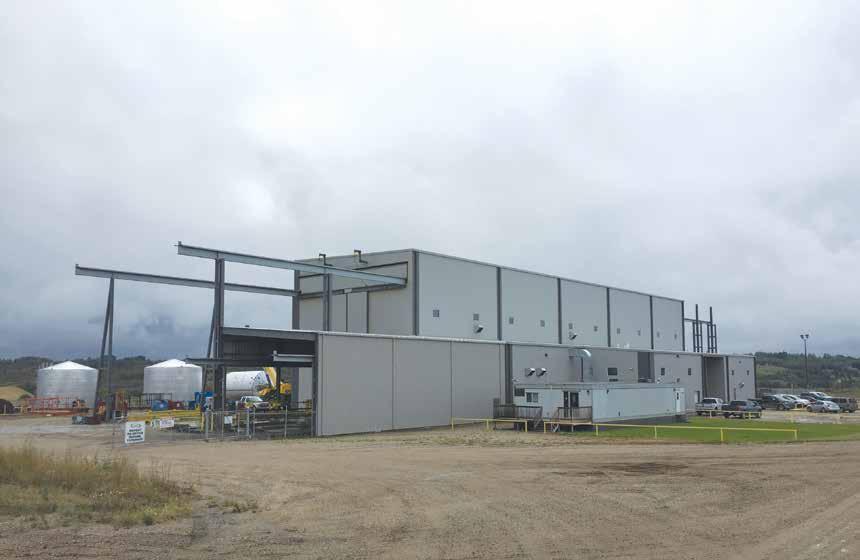



Proudly serving the energy industry in Western Canada since 2010. Leading Manufacturing Group (LMG) is your premier choice for steel manufacturing services. At LMG, we specialize in fabricating high-quality steel storage tanks, pressure equipment, and structural components which are all designed for various industrial applications. Our equipment is engineered for durability, safety, and performance, ensuring they meet the rigorous demands of the oil, gas, and mining sectors. LMG has state-of-the-art facilities in Nisku (Edmonton), Battleford, SK, Vermillion, AB and a dedicated sales
Harfang controls a strong portfolio of exploration assets in the Eeyou Istchee James Bay and Abitibi districts of Québec and Ontario, respectively. With the dual mandate of exploring for high-grade gold, as well as for critical and strategic minerals (CSMs) such as lithium, nickel, copper, cobalt, and platinum group elements (P gEs), the company’s exploration activities are underscored by a social license that prioritizes stakeholder engagement and environmental best practices. harfang’s objective is to create shareholder value by unlocking the mineral endowment through sustained, systematic, and technically based exploration, as well as through partnerships.
The company is backed by various Québec institutional funds along with committed retail shareholders, providing the necessary access to
capital. In ad dition, the company is well positioned with a new and engaged management team, an experienced board, and an asset base across various commodities and two jurisdictions.
h arfang geologists were busy this past summer in Québec exploring for gold and CSMs on six of its 12 wholly owned assets. The overall philosophy of this past summer’s program was for the new management team to evaluate the portfolio, allowing them to gain focus going forward.
At Serpent-Radisson, the goal was to follow up on the Améliane spodumene discovery made in fall 2023. The discovery is highlighted by assay results including: 4.56 per cent Li2O, and 0.82 per cent Li2O over 20.0 metres (incl. 1.46 per cent Li2O over 6.0 metres), in a grab and channel sample, respectively. Summer 2024 exploration


culminated in the Milou spodumene discovery. The Milou discovery is highlighted by assay results including: 2.97 per cent Li2O, 2.17 per cent Li2O, and 2.03 per cent Li2O (all grab samples).
At Lac Menarik, the goal was to follow up on the broad gold intervals drilled at the Pierre and Pierre Ouest zones in winter 2023. These highly altered and brecciated monzonites intervals are highlighted by 1.15 g/t Au over 47.0 metres (incl. 3.75 g/t Au over 7.0 metres), 1.75 g/t Au over 21.0 metres (incl. 2.49 g/t Au over 14.1 metres), and 0.54 g/t Au over 75.0 metres. Summer 2024 exploration focused on additional sampling across key alteration zones, as well as prospecting various IP anomalies and gold showings.
At Menarik Est, company geologists set boots on the ground for the first time and had the opportunity to ground truth historical Ni-Cr-Cu-P gE occurrences
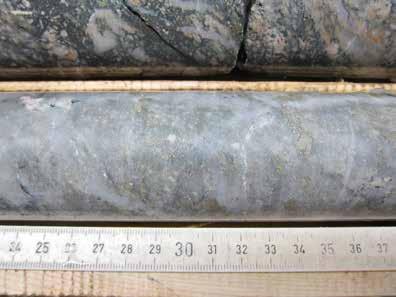
and further understand the Menarik ultramafic complex. The Menarik Est Zone hosts a non-NI 43-101 compliant resource of 6.34 Mt grading 7.73 per cent Cr2O3, 398 ppb Pd and 105 ppb Pt.
h arfang’s exploration activities are underscored by a core commitment to building positive, mutually beneficial relationships with local stakeholders. The Québec assets are located on the traditional lands of the Cree Nation of Eeyou Istchee, and with whom the company enjoys a respectful, collaborative, and mutually beneficial relationship.
On August 9, 2024, harfang announced its intent to acquire all of the issued and outstanding common shares of NewOrigin g old Corp. (TSX v: NEWO) by way of a plan or arrangement. The transaction is predicated on combining h arfang’s Blakelock and NEWO’s North Abitibi projects to consolidate more than 11,000 hectares over a combined 25-kilometre strike length along the prolific Casa Berardi Deformation Zone; and to bring in the Sky Lake g old Project, a 9,100-hectare underexplored

asset in the Pickle Lake g old Camp.
Selected gold assay results from historic drilling at Sky Lake include: 6.26 g/t Au over 22.7 metres (including 8.78 g/t Au over 16.0 metres), 7.26 g/t Au over 19.4 metres, and 6.50 g/t Au over 16.8 metres.
Management believes the acquisition of NEWO will add significant depth to the asset portfolio and set the company up for a greater potential for discovery.
Learn more about h arfang Exploration at harfangexploration.com. 8



A
Kingston Process Metallurgy (KPM) focuses on integrated process development, specializing in both new processes and improving existing ones. At KPM, we aim to provide clarity to potential resource recovery, metallurgy, industrial chemistry and recycling projects and guiding them from concept, through development and scale up, and to finally execution. This includes performing high capital and operating cost estimates, conducting technical reviews, and identifying key process drivers and issues, which help direct lab and pilot work. Our experience and expertise have positioned KPM directly in the path of the critical materials supply chain.
In our experience working within the critical materials space, KPM
has observed that the updated Canadian Critical Minerals list, while comprehensive, still focuses heavily on the mining aspect of the supply chain. This is exemplified in the use of the word “Minerals”, when only two of the 31 items in the list are minerals (fluorspar for fluorine and potash for potassium). The rest are elements, and the use of the word “Minerals” reinforces government mindset rooted in mining. however, critical material supply chains must go far beyond mining, and the materials (or elements) needed to engage the entire supply chain to end product. These materials are fundamental to Canada’s reindustrialization, economic security, and sustainability.
Strategies and plans should focus on mid-term opportunities by recognizing



the importance of establishing “demand-pull” from the midstream. The midstream demand pull encourages upstream supply via mine development or recycling. In contrast, a “supplypush” approach that develops raw materials without domestic mid and downstream capabilities, will primarily benefit non-Canadian entities engaged in value-added processing. Critical materials strategies must distinguish between commoditized materials (e.g., Cu, Ni, Al) and non-commoditized materials (e.g., Nd, Dy, g a, g e), which involve different players and markets.
Additionally, when developing a new supply chain, strategies need to account for key substances required in the processing of energy transition materials, such as sulphuric acid (h 2 SO 4) for the extraction of rare earth elements, and helium for semiconductor manufacturing. These substances may not be present in the final products but are essential to the production process. Addressing potential shortfalls in these processing chemicals is crucial for a sustainable supply chain.
KPM also highlights the importance of anticipating future applications, especially next-generation energy storage and battery technologies, as these evolving demands may render today’s battery formats obsolete. The company stresses that Canada’s Critical Materials List should keep pace with these technological advancements and consider materials that will be needed in the future for these applications, including their forms, compositions, and volume demands.
In terms of criteria for identifying critical materials, Canadian companies often hold mineral rights outside


of Canada and can contribute to critical materials production through midstream processing, even when the raw minerals are sourced from abroad. Additionally, Canada’s growing recycling capabilities will increasingly rely on imported feedstocks, not necessarily minerals produced domestically. KPM sees recycling as a key opportunity for closing supply chain gaps by reducing reliance (at least at the outset) on mining for critical materials.
KPM’s focus on critical materials goes beyond mining to emphasize
the importance of processing and downstream capabilities. We are actively involved in innovative recycling projects and aims to find sustainable ways to kickstart and stabilize supply chains, whether through traditional mining or recycling initiatives. KPM’s role is to provide the expertise and guidance necessary to navigate these challenges and contribute to the successful development of critical material supply chains, which are foundational to the green transition, economic security, and future technological advancements. 8
Canada defines critical minerals (CM) using four essential criteria: their importance to the digital economy, the risk of supply shortages, their role in combating climate change, and their strategic value to the nation. In response to these factors, Natural Resources Canada (NRCan), in collaboration with provincial, territorial, and industry experts, has identified 34 critical minerals. To guide the country’s efforts in mining and mineral development, NRCan developed the Canadian Minerals and Metals Plan (CMMP), a strategic framework designed to secure Canada’s position in this essential sector.
Among the Canadian territories, the Northwest Territories (NWT) stands out as one of the few regions that can claim to be a producer of critical minerals. At least 24 of the 34 minerals deemed critical by NRCan have been discovered within the NWT. Six major projects are already in the early stages of mining and advanced exploration, but this represents just a fraction of the region’s true potential. The NWT’s
vast untapped reserves, combined with its strategic advantages, make it a key player in Canada’s critical minerals industry.
Several factors give the NWT a competitive edge in the global race for critical minerals. These factors include a stable political and fiscal environment, a well-established legal system, and sound banking frameworks. Unlike other regions that may face instability or fluctuating regulations, the NWT offers consistency, which is crucial for investors and mining companies.
furthermore, the NWT has a long history of mining, which has fostered a highly skilled and experienced workforce, both Indigenous and nonIndigenous. The local population is generally accepting of mining as a vital part of the economy, contributing to a positive business climate. This experience and support create a solid foundation for further development in the critical minerals sector.
The g overnment of the Northwest Territories (gNWT) has a clear vision for the future of critical minerals exploration and development. This vision is centered on promoting these opportunities in ways that benefit NWT residents and their communities, while also supporting Canada’s broader goals. These include advancing Indigenous reconciliation, implementing the United Nations Declaration on the Rights of Indigenous Peoples (UNDRIP), and addressing climate change.
To achieve this vision, the gNWT is taking a multi-faceted approach. f irst, it aims to raise awareness and deepen understanding of critical minerals among both the public and government bodies within the NWT. By doing so, the gNWT seeks to increase local support and engagement with the sector.
Second, the government is actively marketing and promoting the NWT’s potential for critical minerals on a national and global stage. This effort includes highlighting the territory’s
This vision is centered on promoting these opportunities in ways that benefit NWT residents and their communities, while also supporting Canada’s broader goals. These include advancing Indigenous reconciliation, implementing the United Nations Declaration on the Rights of Indigenous Peoples (UNDRIP), and addressing climate change.
wealth of mineral resources, skilled labour force, and investment-friendly environment.
Third, the gNWT is working to expand its own knowledge of critical minerals. By investing in research and gathering more data about the NWT’s resources, the government aims to position the territory as a leader in this field.
f inally, the gNWT is focusing on building and strengthening partnerships with Indigenous governments, the federal government, and industry stakeholders. By collaborating closely with these groups, the gNWT can ensure that development is not only economically successful but also socially and environmentally responsible.
pillArs of opporTuniT y
The development of these strategic pillars holds tremendous promise for the future of the NWT. Critical minerals exploration and production are on the rise, and the territory has several key advantages that make it an attractive destination for investors. These include a well-trained workforce, modern legislation that supports sustainable development, and ongoing infrastructure projects that will improve access to remote mining sites.
In addition, the NWT has a proven track record of responsible environmental and socio-economic management. This history of balancing development with environmental stewardship makes the region particularly appealing to companies and investors with a strong focus on Environmental, Social, and g overnance (ES g) principles.
Indigenous partnerships are another cornerstone of the NWT’s approach
to critical minerals development. By working closely with Indigenous communities, the gNWT is ensuring that economic benefits are shared and that development respects local rights and traditions. This collaborative approach strengthens Canada’s commitment to Indigenous reconciliation while promoting sustainable growth.
The NWT’s rich reserves of critical minerals, combined with its strategic advantages, place it in a pivotal position to become a leading supplier of these vital resources to the world. With rising global demand for critical minerals to power the green economy and technological innovations, the NWT has the potential to play a crucial role in Canada’s efforts to secure a reliable, sustainable supply of these materials.
The gNWT’s focus on responsible development, Indigenous partnerships, and environmental sustainability aligns with global trends toward ES g -
conscious investing. This makes the territory an attractive destination for project developers and investors seeking long-term value.
As the world moves toward a lowcarbon future, critical minerals will be essential for everything from renewable energy technologies to electric vehicles. The NWT, with its vast mineral resources and commitment to sustainable development, is wellpositioned to meet this demand and contribute to Canada’s leadership in the global critical minerals market.
In conclusion, the NWT’s critical minerals strategy offers a unique opportunity for economic growth, environmental stewardship, and Indigenous reconciliation. By leveraging its competitive advantages, building strong partnerships, and focusing on sustainable development, the NWT can secure its place as a key player in the critical minerals industry, benefiting the territory, Canada, and its allies and trade partners. 8
info@matexdrillingfluids.ca matexdrillingfluids.ca



There are currently almost 50 companies exploring for critical minerals in Manitoba, representing over 70 per cent of all exploration companies operating in the province.

Critical minerals are used in a range of essential products we use every day, from mobile phones and electric vehicle batteries to solar panels and medical applications. Manitoba is home to 29 of the 31 minerals on Canada’s 2021 critical minerals list, including lithium, graphite, nickel, cobalt, copper (which has been mined in the province for over a hundred years), and rare earth elements.
These minerals are crucial for Manitoba’s growth as a low-carbon leader and are essential to developing clean technologies, energy storage systems, electric vehicles, and other technologies that advance net-zero targets.
“Critical minerals provide Manitoba with a new opportunity to focus on mineral resources and attract investments and opportunities,” says MaryAnn Mihychuk, president of the Manitoba Prospectors and Developers Association (MPDA). “That means we generate wealth for our province so our provincial governments that can pay for roads, fix our potholes, build schools, etc. Minerals have the best potential for wealth creation. And the new green economy needs critical minerals.”
Sixty per cent of Manitoba lies within the Canadian Shield, which hosts gold, diamonds, nickel, copper, and lithium. But according to Mihychuk, the province is also fortunate to have a couple of critical minerals in the south.
“If you think about the south minerals, you may think of potash in Saskatchewan. You go along the highway and see potash mines,” she says. “The Saskatchewan government receives between $4 and $6 billion a year on potash royalties alone, nevermind all the supply and services that are part of that economy.”
She goes on to say that Manitoba has that opportunity with silica since the province’s silica deposit is 99. 5 per cent pure, which is needed for computer chips and solar panels. It’s located in the ground in both Winnipeg and in Beausejour, and goes almost all the way over to Brandon. The ability for southern communities to become part of the mineral economy is real, she says, and the door is ready to be opened.
Mihychuk adds that Manitoba needs to be a leader and make the most of this, particularly with the price of silica reaching upwards of $800 per metric ton.
By Lyndon McLean
One project on the way to approval is Canadian Premium Sand’s Wanipigow Sand Extraction Project in Seymourville, near the hollow Water f irst Nation.
This would provide the rare high-purity silica sand needed for solar glass manufacturing. That deposit is at surface in Black Island in Lake Winnipeg, within the Winnipeg formation. This high-purity silica deposit also provides the whiteness that gives the appearance of snow near grand Beach, which is a feature that the beach is known for.
“We’re just beginning,” Mihychuk says. “With the project near Beausejour that didn’t get approval, the science was there. They didn’t seem to actually prove it sufficiently to the community to reassure them their water would be protected. But some 12,000 holes have been drilled in these rocks without any water contamination, so that’s important. It’s not like new technology. It’s the same method used for the potash mine or to extract salt, so Manitoba has a history of using solution mining and doesn’t cause pollution.”
She says it may be a case of the neighbouring community to say this is a real opportunity to provide a job for every high school graduate, to have some money for that community centre, or find a doctor and build the community.
Lithium is another mineral the explorers are having success with in the province, with the Tanco mine in Lac du Bonnet being a major source. grid Metals is also working nearby, and companies such as foremost Lithium, ACME Lithium,
1911 gold, and several others are making inroads in the Snow Lake Belt.
Mihychuk notes that the Island Lake region has a lot of potential for critical minerals as well.
“ from St. Teresa Point up to Red Sucker, the Ontario border, and over to Cross Lake – in that area, there are over 1,400 known mineral occurrences. That means companies might have an opportunity to go and check that out,” she says. “We should have 600 companies working in that area, and we have zero. Perhaps once we work with the f irst Nations, who [must grant approval] must consent to the project along with the provincial government. The f irst Nations are looking at the industry but really haven’t bought in. Once that happens, and they understand the opportunities available to them, it could change Manitoba’s future in a very bright and positive way.”
In general, the Manitoba government is very positive on mineral development, in spite of being “stuck with regulatory red tape”, as Mihychuk notes. “Companies are drowning in red tape, but it’s easy to understand how much it would mean to the treasury, so that’s very important.”
The f irst Nations, on the other hand, haven’t really received much or anything from mineral exploration and mining, which has left them with no benefits in their traditional territory. So, they’re wondering, why should we participate? What does it mean to us?
“But times have changed. Because of their hard work, f irst Nations have really challenged the Constitution and Section 35 that Pierre Trudeau brought in which recognized Indigenous rights, so there’s a new platform. And our association, the MPDA, is like a small chamber of commerce. We are partnering with f irst Nations, and it’s our number-one priority for them to become full partners with us,” Mihychuk says.
Mihychuk points to the case of Tahltan f irst Nation in Northern B.C., who opened up to mineral development and saw benefits. Jerry Asp of Tahltan spoke at the MPDA’s reconciliation gala in March and told of how, in 20 years, they went from 98 per cent unemployment to 100 per cent full employment, with $175 million in a trust account, providing dividends for every member of the f irst Nation.
“Jerry understands the power of minerals and the money involved, and he’s part of the community,” she says. “ he understood that that could mean significant scholarships for the young people to go to school, to become geologists and engineers, environmental scientists, accountants, or lawyers. It’s just transformed the community – and that’s exactly what can happen here.”
She also notes that Matthew Coon Come and the g rand Council of Crees around James Bay, Ontario welcome exploration companies because they understand that only one in 1,000 projects will be successful. In December 2023, they entered into the Kapisikama Agreement, regarding the development and operation of the James Bay Lithium project in Eeyou Istchee, a lithium openpit mine in the traditional territory of the Cree Nation of Eastmain.
“So, they have 600 exploration companies working in their territories,” Mihychuk says. “You want them to be searching in your area, and if they discover something, they have to negotiate a deal with the f irst Nations. And the g rand Council has seen massive investments in their communities, the same sort of benefits like the Tahltan.”
Another challenge of moving ahead with critical mineral exploration is the permitting process, which has been arduous. Prospectors, exploration companies, and associations like the
MPDA have long lobbied for a smoother, quicker process, one that gives everyone a say and a share but doesn’t take years. Again, Mihychuk points to another region, this one halfway around the world.
“There was an election in New Zealand recently, and the new Prime Minister has come in and said he’s going to reduce permitting to six months. They used to take two years,” she notes. “Now every company in the world is looking to the ‘land of hobbits’. You’re going to have a very positive, supportive government that can quickly turn over permits, and money will be moving – but that’s not what we want. We want that money to stay here. We want it in Manitoba, right? So, let’s pay attention because the money flows so quickly. We must compete not only with Ontario, but with New Zealand.”
While there are currently almost 50 companies exploring for critical minerals in Manitoba, representing over 70 per cent of all exploration companies operating in the province, Mihychuk says she’s not aware of any Manitoba exploration companies working there. There’s a few of them, and none of them are working on projects in Manitoba. That in itself says something about how the province must change and open things up. Open up the Mines Act – change it, modernize it, and make Manitoba competitive.
Manitoba certainly has critical mineral potential, but the feeling is, it’s underexplored.
“If we can turn the page, if the door opens, we will see significant expansion and prosperity,” Mihychuk notes. “And those companies will come this way. They’ll move where there’s an opportunity They don’t know boundaries.” 8

Founded in 2013, North American helium Inc. (NA h) has been committed to the exploration and production of helium from underground fields of inert nitrogen, as well as to replace declining legacy helium sources in North America with more reliable and sustainable sources that are geopolitically secure.
The company brought two new production facilities online in 2024, marking its eighth and ninth plants corporately. To support future growth, it continues to actively explore in several new geographic areas of its nine-million-acre land base – running the most active helium exploration program in the industry.
helium’s unique physical properties make it vital for several high-technology applications where there is often no substitute. helium’s low boiling point and non-reactive nature make it vital for the pressurization and purging of liquid fuels in rockets for space exploration and satellite infrastructure.
Helium is also a small but critical input in fibre-optic cable production, semiconductor manufacturing, MRI machines, and certain welding applications due to its high heat capacity.
NA h ’s ability to scale up the business quickly was possible in part through progressive incentive programs such as those recently announced by the g overnment of Saskatchewan, and which have ultimately led to NAH attaining another significant milestone – $0.5 billion of investment in Saskatchewan.
The recently announced incentives include the new Critical Minerals Processing Investment Incentives (CMPII) and the Saskatchewan Critical Mineral Innovation Incentive (SCMII), which were created specifically for critical minerals projects in Saskatchewan and replace the Oil & g as Processing Investment Incentive (O g PII) and the Saskatchewan Petroleum Innovation Incentive (SPII) programs for our industry.
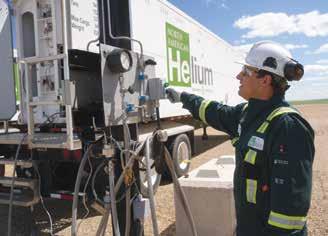

NA h has been able to utilize these incentives for six of our helium purification facilities under the OGPII program, including our Battle Creek facility, Canada’s largest helium processing facility, and two projects under the SPII program. The Antelope Lake facility and any future helium facilities will benefit from the incentives provided for under the new CMPII program. A potential helium liquefier, which would be Canada’s first, would also benefit under the new CMPII and the SCMII programs.
Programs such as the new CMPII and the SCMII for helium processing projects are additive to our investment capability and continue to be critical for us to attract new investment funding to execute on our growth plans.
Helium’s unique physical properties make it vital for several hightechnology applications where there is often no substitute.
This continues to be an exciting time in NA h ’s development, with technical learning and data science serving as the foundation of our path forward. Our recent discoveries are a result of the company’s robust ongoing exploration program. To date, we have drilled over 100 helium wells, which have provided the reserves for our operating plants, as well as a number of future opportunities being advanced toward production.
Our exploration efforts have resulted in more than a halfdozen unique helium play types being proven up across our vast acreage position. Additional new play concepts, derived

Operator of multiple helium purification facilities including Canada’s largest – representing over 7% of North American supply
Low Emissions Sourced Helium
Sourced from deep, high-pressure nitrogen fields that have significantly lower full-cycle1 emissions than hydrocarbon-based sources
1 Full-cycle is defined as estimated Scope 1, 2 and 3 emissions.
Delivering gaseous and liquid helium to our customers around the world reliably since 2020
Future volumes available on long-term contract or spot sales
Over 100 wells drilled to date, with additional discoveries being advanced toward production


from the vast experience of our geoscience teams in energy resource exploration, are in various stages of testing and delineation.
NAH brought its first helium production facility on-stream in the summer of 2020. four short years later, we are now producing approximately seven per cent of all helium supply in North America.
The low-emissions-sourced helium in southwestern Saskatchewan is sourced from deep, high-pressure nitrogen fields that have significantly lower full-cycle emissions than hydrocarbon-based sources. Nitrogen is clean, constitutes most of the air we breathe, and is much less expensive to
To date, NAH has drilled over 100 helium wells, which have provided the reserves for our operating plants, as well as a number of future opportunities being advanced toward production.
NAH brought its first helium production facility on-stream in the summer of 2020. Four short years later, we are now producing approximately seven per cent of all helium supply in North America.
operate the facilities as there are no corrosive or hazardous substances.
Many major end-users of helium are all looking at ways to lower their environmental impact and the carbon footprint of their supply chain. NA h is focused on growing low-emissionssourced helium production quickly so that we can be a part of that solution for them.
North America continues to move towards being a net importer of helium, not only due to the declining supply from legacy sources, but also because of strong demand from growing sectors like semiconductor manufacturing and space exploration. Recognizing that our journey towards a more sustainable future is ongoing, North American helium stands ready to invest in our business to be a sustainable partner for helium end-users in North America. 8
Canada possesses significant amounts of the critical minerals needed for the transition to a green economy. The nation can be a world leader in supplying these critical minerals, but the opportunity cannot be seized without attracting more workers into the sector.
Workforce skills shortages are one of the biggest risks when it comes to supplying the world with critical minerals and metals. A robust supply of skilled exploration and mining workers is needed to support expansion, avoid ongoing labour shortages, and ensure the minerals and metals sector’s sustainability and competitiveness.
Yet, Canada’s mining talent pipeline is shrinking. Long-term forces undermine the labour supply’s ability to respond to periods of growth –such as rising retirements, a widening worker age gap, and continued underperformance in attracting underrepresented groups.
Post-secondary enrolment in geoscience- and mining-related programs is also dwindling. While undergraduate enrolment across all engineering programs is increasing, mining engineering enrolment decreased by 50 per cent from 2012 to 2023 – the largest decline of any engineering discipline. geological engineering enrolment was down nearly 40 per cent, and other miningrelated programs are experiencing similar declines – highlighting a bottleneck for attracting new talent.
widening Age gap: share of workforce by Age Category, mining, quarrying & oil and gas extraction

Source: Mining Industry Human Resources Council; Statistics Canada, Labour Force Survey, 2023.
undergraduate enrolments and degrees Awarded in mining or mineral engineering (2012 to 2023)

*Forecast from 2021 onwards assumes present trends continue. Source: MiHR; Engineers Canada, Canadian Engineers for Tomorrow: Trends in Engineering Enrolment and Degrees Awarded Report; Canadian Mining Schools Committee (CMSC), Survey of Canadian Mining Engineering Schools, 2023.
post-secondary enrolment (Bachelor’s and Below) and graduates by institution, geosciences (2009 to 2023)

Mining has also historically struggled to diversify its workforce. for instance, the latest trends on representation in the workforce show that, relative to other industries, mining continues to underperform with women and newcomers. Women make up just under half of the Canadian labour force but only represent 14 per cent of the mining industry – and while 30 per cent of the overall workforce is made up of immigrants, they only represent eight per cent in mining.
These stagnant and shrinking supplies of talent come at a time when demand for critical minerals is increasing along with the industry’s demand for skilled personnel. The industry has grown significantly since 2020, with employment having gone up by about 40 per cent, and approximately 50 per cent of the sector’s workforce required some form of post-secondary education in 2020. That number is now closer to 75 per cent.
higher job vacancy rates are also being experienced and labour market pressures may get more intense. Solutions require an all-hands-on-deck mentality. No organization or company can do this alone. Companies of all sizes and academia are needed to collaborate to grow and sustain a healthier talent supply.
A sustained, unified voice is needed to reach the next generation of minerals and metals workers. Addressing the challenge starts with communicating the sector’s importance and the breadth of careers it offers to Canadian youth, immigrants, and other underrepresented groups who are unaware of, or look negatively on mining careers. They need to be inspired to create the change required to increase post-secondary educational enrolment and diverse sources of labour.
As the national organization that
provides labour market information and leads collaboration across Canada’s mining sector to identify opportunities and develop solutions, the Mining Industry human Resources Council (MihR) is working towards operationalizing a pan-Canadian coalition of industry stakeholders to coordinate efforts through its Mining Needs You (www.miningneedsyou.ca) brand to address the sector’s talent crisis. Mining Needs You was launched in 2021 to showcase to youth and other key audiences what modern mining looks like, its use of innovative technologies, and industry’s commitment to environmental sustainability and equity, diversity and inclusion (EDI).
By prioritizing EDI initiatives, Canada’s mining industry has also been taking important steps to create inclusive workplaces where everyone feels valued, respected, and empowered to succeed. To help drive systemic change, members of the Mining Association of Canada (MAC), who account for most of Canada’s base and precious metals production, adopted a Towards Sustainable Mining (TSM) Protocol on Equitable, Diverse and Inclusive Workplaces. globally recognized, TSM drives mining companies’ performance in managing key environmental and social risks, including biodiversity conservation, water stewardship, Indigenous and community relations, and more.
The TSM EDI Protocol requires MAC member companies to develop and implement corporate EDI strategies, processes to foster welcoming workplace cultures, and approaches to EDI objective setting at mine sites. To assess performance and measure progress, the Protocol outlines criteria associated with three indicators: 1) corporate level leadership and strategy, 2) facility level advancement of EDI, and 3) facility level monitoring, performance and reporting.
Mining companies can leverage three key tools to establish workplaces in line with the protocol and its criteria: MihR’s EDI Toolkit for Mining Companies, its diversity eLearning, and ENSEMBLE: The Mining Diversity Network.
MihR’s EDI Toolkit helps companies develop and implement corporate EDI strategies. Organized by TSM performance indicators, it helps mining organizations streamline their efforts and move from ideation to implementation, evaluation, and reporting. v isit mihr.ca/inclusiondiversity/mining-edi-supports to learn more.
MihR’s diversity eLearning modules provide professional development and micro credentials for Canada’s mining industry. Taken by thousands of learners by registering at mihr. ca/cmsds/elearning, they focus on intercultural awareness; Indigenous awareness; gender equity in mining; and bias, systemic discrimination, and anti-racism.
ENSEMBLE: The Mining Diversity Network enables its members to network and collaborate in identifying and addressing barriers to full and equitable participation in the workplace. ENSEMBLE also includes resources to assist individuals and organizations along their journey towards inclusion in mining. Individuals can sign up at mihrensemble.com.
Despite the challenges, long-term efforts will yield material progress. To help Canada transition to a green economy, the minerals and metals sector needs to come together to communicate its importance and inspire key audiences to consider exploration and mining education and careers. 8


Mitigate risk and maintain water release compliance with Clearflow’s Gel Flocculants. Field proven technologies that lower costs, safeguard the environment, and improve sustainability.






Simplify Dewatering Treatment with Clearflow’s Gel Flocculant Reactor.
This mobile flow-through device is placed inline without the need for dosing equipment or additional power to flocculate TSS, phosphorus and metals. Eliminate the potential for spills while reducing the need for skilled labour and the high operational costs associated with traditional flocculation systems.
During construction of the Cote Gold mine in Ontario, Canada, 17 of Clearflow’s GFR1000 Reactors were successfully used to dewater and treat two million m3 of water.
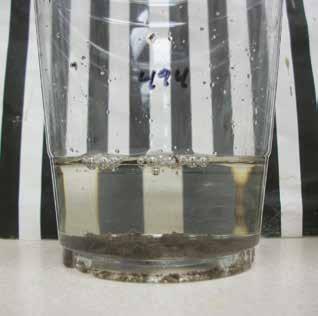

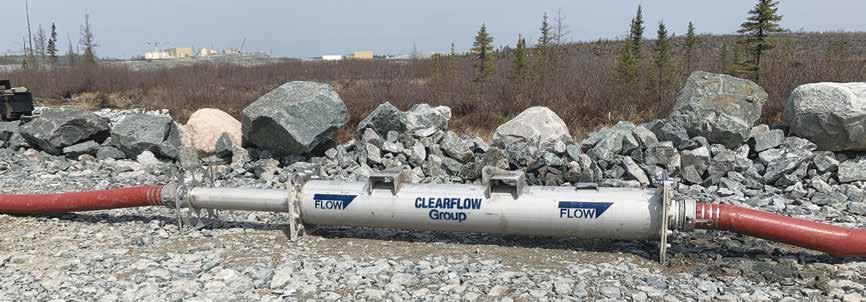


WBy Isabelle Leblanc, Vice-President, Mining and Metals, BBA
hen it comes to reducing carbon emissions, the mining industry has two roles to play. f irst, it needs to meet and supply the growing demand for minerals that are essential to decarbonization. Second, it needs to make profound changes to reinvent an industry that has been established for over 100 years and reduce its own greenhouse gas emissions.
Driven by social and economic imperatives, the mining industry in Canada is undergoing significant changes, prompting various stakeholders to speed up their shift toward cleaner energy.
With many Canadian mines planning their renewable energy transition, the focus is turning toward transport, which accounts for most of the sector’s greenhouse gas (ghg) emissions.
Electrifying transport operations can make it possible to fight climate change and meet ghg reduction targets while improving worker health and safety with cleaner air and reduced noise.
Electrification can also lower operating costs over the long term and reduce dependence on fossil fuels, futureproofing operations. Since digitalization and electrification also tend to go hand in hand, production forecasting accuracy can also increase while the mine improves its ES g report and supports social acceptance.
for example, implementing a trolleyassist system (TAS) can have a substantial impact on fuel consumption and corresponding greenhouse gas emissions. Implementing a TAS on a haul ramp segment can lead to a significant reduction in ghg emissions when
compared to using diesel-powered haul trucks. It can also reduce operating costs by tapping into hydroelectric power instead of diesel, and by improving truck-cycle time, enabling mines to be more efficient.
There may also be public funding opportunities in your area to assist with feasibility studies and the actual electrification process. however, this transition is neither quick nor easy; electrifying transport requires a great deal of planning. This can mean adapting facilities, supporting employees in adopting new work methods, and investing substantial funds upfront.
Making an informed decision requires a detailed assessment that reflects several factors. Some factors that must be considered include the remaining
mine life, the brownfield limitations, and the impact of electrification on mining activities, as well as any tax and government incentives.
There are also other options to consider if electrifying transport is not feasible. Using a conveyor or train, tapping into alternative fuels, and even optimizing routes to reduce vehicle distances can all be viable options. Many promising technologies are also currently under development that should enable more mines to one day electrify their transport.
Cost: Is this a financially viable option for you?

Infrastructure: Is your site optimized for this?
BBA has been providing a wide range of consulting engineering services for over 40 years. Today, its engineering, environmental, and commissioning experts team up to quickly and accurately pinpoint the needs of industrial and institutional clients. The firm’s expertise is recognized in the energy and natural resources industry. With 20 offices in Canada and internationally (USA and Chile), offering clients local support and field presence, BBA provides some of the industry’s most innovative, sustainable, and reliable engineering solutions. 8




Baseline: What are your electrification goals?
Mining: Do your design and planning support electrification?
Distribution: Will it be easy to distribute power to these areas?
Transmission: How are you connected?





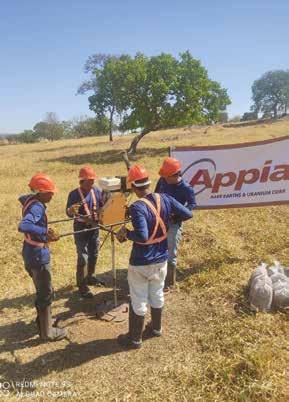
Appia Rare Earths & Uranium Corp., a publicly traded company, aims to strategically position and capitalize on the increasing demand for critical minerals, such as rare earth elements (REE) and uranium. These resources are essential for meeting the high demand for electric vehicles, wind turbines, and advanced renewable electronics, and driving the transition towards a greener environment. Appia is a critical mineral exploration company committed to advancing multiple rare earths and uranium projects in mining-friendly regions, including g oiás State, Brazil, the Athabasca Basin in Saskatchewan, and Northern Ontario, the latter two of which are in Canada.
Investing in Appia offers a unique opportunity to tap into the growing demand for rare earth elements and uranium, which are pivotal in powering various industries. As the world transitions to cleaner energy sources and advanced technologies, the demand for rare earth elements and uranium is on the rise. Appia’s strategic positioning in these markets make it a compelling choice for investors looking to align their portfolios with the future of clean energy, high-tech innovation, and responsible resource development. By investing in Appia, you not only stand to benefit from the potential financial rewards, but also contribute to a cleaner and more technologically advanced future.
In early 2023, Appia secured the right to acquire up to a 70 per cent interest in a very promising ionic absorption clay (IAC) project near the town of Iporá, in the state of g oiás, Brazil, covering a large +40,000-hectare project area. With a specific focus on the identification of the highly sought-after heavy REEs of Dysprosium (Dy) and Terbium (Tb), the PCh project results to-date demonstrates its potential as a future source for these extremely important minerals for the permanent magnet industry.
Over the past year, Appia has accomplished an amazing amount of work, and achieved many milestones, including a maiden Mineral Resource Estimate (MRE) on its first two targets,

Target I v and Buriti Zone, including an inferred total resource of 46.6 million tons with an average grade of 2888 ppm Total Rare Earth Oxide (TREO) and indicated total resource of 6.6 million tons with an average grade of 2523 ppm TREO; completed desorption testing across various targets confirming the ionic clay characterization of the mineralization while continuing to see very favourable kinetics across all the desorption testing. They identified an additional four new highly prospective target zones covering an area of over 2,400 hectares while re-confirming that the regolith developed over the Iporáa granite presents significant enrichment of hREO, indicative of IAC REE deposits.
The PCh project is extremely important to the company as it leverages Brazil’s natural advantages in mineral production cost-efficiency, which is crucial for the global market. Additionally, the project’s location offers excellent infrastructure support—roads, power, water—and, very importantly, strong local community support. The company’s approach on the ground at the PCh project has fostered solid relationships with local farm owners, further enabling smooth operations and governmental buy-in from local to federal levels. The ionic absorption clay’s high grades, at depths up to +24 metres, points to the viability and potential of the project, and showcases the PCh project’s scalability and potential cost-effective nature.
These are important results that demonstrate further that Appia has
Appia’s consulting geologist, Mr Don Hains, examining clay samples at the PCH Ionic Adsorption Clay project in Goias, Brazil.
discovered a notable ionic clay rare earths deposit. The PCh project has many superior characteristics including its hosting in easy-to-dig clays, a desirable diversity of metals, including the “rare” rare earths, the high grades encountered, and the large scope of the project. Industry has a growing need for rare earths in a stable and western jurisdiction and the company is committed to offering a solution.
Appia is a publicly traded Canadian company in the rare earth element and uranium sectors. The company holds the right to acquire up to a 70 per cent interest in the PCh Ionic Adsorption Clay Project (see June 9th, 2023 press release), which is 40,963.18 ha. in size and located within the g oiás State of Brazil (see January 11th, 2024 press release). The company is also focusing on delineating high-grade critical rare earth elements and gallium on the Alces Lake property, and exploring for highgrade uranium in the prolific Athabasca Basin on its Otherside, Loranger, North Wollaston, and Eastside properties. The company holds the surface rights to exploration for 94,982.39 hectares (234,706.59 acres) in Saskatchewan. The company also has a 100 per cent interest in 13,008 hectares (32,143 acres), with rare earth elements and uranium deposits over five mineralized zones in the Elliot Lake Camp in Ontario. 8



As the global demand for critical minerals rapidly increases, it is necessary to optimize their exploration and production to achieve the global transition towards a greener future. To meet this growing demand, the mining and exploration industry must adopt efficient exploration techniques.
A traditional post-drill exploration workflow consists of logging by a core logging geologist, followed by sending samples to an external laboratory for chemical analysis. Core logging is often performed by many different geologists, resulting in inconsistent interpretation and subsequent resource modeling. In addition, there is often a delay between sampling and receipt of results, which can then lead to further delays or sub-optimal decisions regarding drilling targets and exploration strategies.
In recent years, many exploration and mining companies have turned to the digitization of drill core using commercial drill core scanners to improve the speed and detail of logging and to better understand ore deposits. These core scanners have traditionally used near-infrared hyperspectral imaging (hSI), X-ray fluorescence (XRF), or a combination of both to provide mineralogical (in the case of hSI) and elemental (in the case of XR f ) information in a relatively quick and affordable manner. While convenient, there are limitations to
these technologies. Near-infrared hSI cannot identify metal oxides and sulfides, or quartz, as these minerals are not spectrally active. Species of carbonates and many silicate minerals cannot be distinguished from one another. XR f, on the other hand, is unable to detect light elements (Z < 13). Mg (Z = 12) and Na (Z = 11) can be detected but require longer dwell times that are not conducive to rapid core scanning.
ECORE, manufactured by ELEMISSION Inc., based in Montreal, is a fully automated, high-speed laser-induced breakdown spectroscopy (LIBS) commercial drill core scanner that is capable of detecting virtually every element on the periodic table (from h to U), which includes every element involved in the list of critical minerals.
With ELEMISSION’s proprietary and easy-to-use LIBS CONTROL software and Smart Automated Mineralogy (SAM) algorithm, users have access to fast and accurate quantitative mineralogical and chemical assays within minutes (approximately five minutes per core box at standard resolution), allowing for real-time decision making. The versatile nature of ECORE technology allows analysis of various sample types (core, chips, pellets, pressed powders, rock slabs) with minimal sample preparation.
Understanding the mineralogy of a deposit is important not only to optimize production and planning for future extraction, but also for understanding controls on mineralization to facilitate exploration.
Figure 1. A photograph, a mono-elemental Cu map, and a SAM image from a 50 µm resolution LIBS scan of a section of drill core from a massive sulfide deposit.



ECORE offers high-resolution mineral data that fits your orebody from 30 um to 1000 um, giving you the power to discover more.


High-Quality Mineral Data:
Achieve the precision of SEM-EDS directly on your samples: drill core, cutting and grade control samples.
Define Geological Domains: Leverage mineralogy to define geological domains accurately.
Mitigate the Impact of Deposit Variability:
Ensure the selection of truly representative samples at each study stage of your project development, making sure you are working with truly representative samples for pre-performance testing.
ECORE’s cutting-edge microanalysis technology promotes collaboration and decision-making at each stage of the value chain of your mining projects.

ECORE’s use of LIBS technology allows for the direct detection of sulfide minerals, which typically host critical metals such as copper, nickel, cobalt, lead, and zinc. Since these deposits typically consist of greater than 40 per cent sulfide mineralization, the ability to differentiate these species and visualize textural relationships is critical. The selectivity of LIBS spectra allows users to distinguish between sulfide minerals of similar composition such as pyrite (feS 2) and pyrrhotite (fe1-xS, x = 0 to 0.17), and iron oxide phases. Using ELEMISSION’s Smart Automated Mineralogy (SAM) algorithm, users can quickly generate mineralogical maps (f igures 1 & 2) to highlight different textures and mineralogical relationships for
easy visualisation of mineralization behaviour within the core. Combined with elemental mapping, users can also determine mineral-elemental relationships, as well as compositional variations within minerals.
Lithium plays a critical role in the global transition to clean energy. It serves as a critical component for batteries and increasing its supply is paramount to the current electric vehicle revolution. ECORE’s ability to detect light elements (e.g., Li, Be, Na, K, Rb) is extremely useful in the exploration of lithium pegmatites, as these elements are common in their mineral assemblages. The direct signal received from these elements also allows for the
Figure 2. A photograph and a SAM image from a 250 µm resolution scan of a slab of rock from a seafloor massive sulfide deposit.
discrimination of minerals that are similar in composition. This can be seen in f igure 3, where using R gB mapping, spodumene, and petalite are easily distinguished from one another within the same core sample. feature mapping like this has proven to be very useful not only for distinguishing between mineral phases but also for highlighting compositional variations within the same mineral. ECORE technology also has the added benefit of providing predicted and true chemical assays in real time, eliminating the weeks or months of delay that is typically associated with waiting for traditional laboratory assay. f igure 4 shows chemical assays taken at one-metre intervals over 1,500 metres of drill core from a lithium pegmatite deposit compared to assays obtained by a standard laboratory method (ICP-AES, four acids). The R² value (0.98) and the slope of the curve (0.99) show a very strong correlation between these two methods, demonstrating that ECORE is as effective and reliable as traditional laboratory methods.
ECORE revolutionizes the extraction and discovery of critical minerals by providing large amounts of information quickly, allowing for faster and more accurate interpretations to be made during the exploration, mining, and production stages. ECORE’s ability to detect almost any element on the period table minimizes the need for additional analytical methods, optimizing the entire exploration process. 8
Figure 3. A photo, an RGB (Li, Al, Si) map, mono-elemental maps for Rb, Be, and Li, and a mineralogical map generated from a section of drill core from a lithium pegmatite deposit.
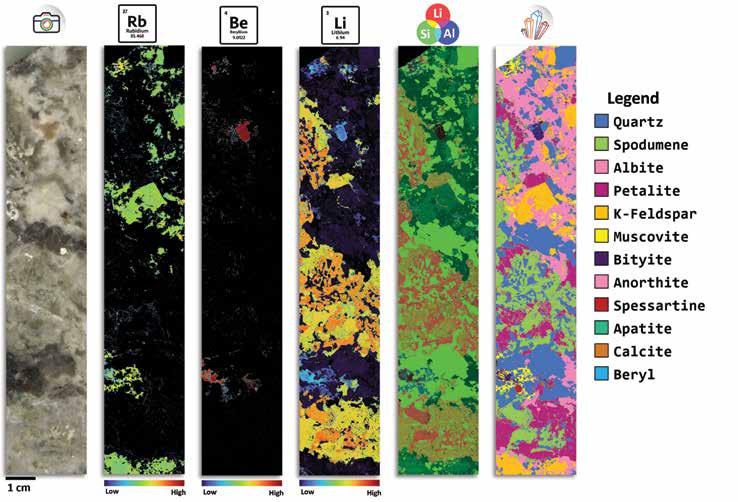
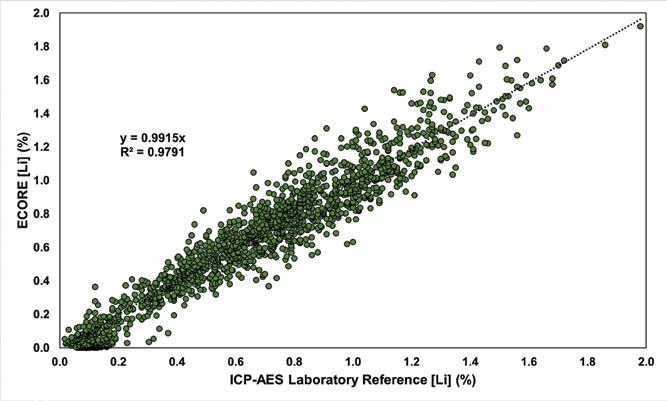
By Dan Baxter, Material Handling Sales, FEECO International, Inc.

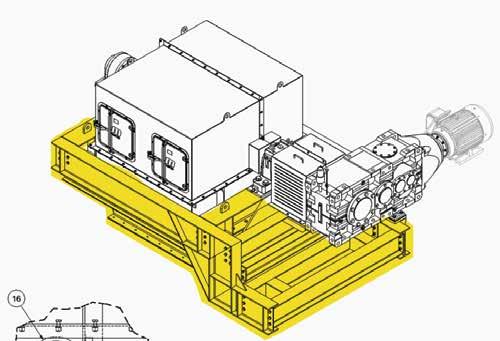
Self-supporting bucket elevators provide a crucial alternative to traditional large super-capacity designs that rely on structural steel for support. These heavy-duty elevators are a favoured approach to vertical handling at potash sites, particularly in outdoor applications or settings where integrating the necessary structural steel isn’t possible or cost-effective.
While self-supporting bucket elevators are operationally similar to their steelsupported counterparts, they differ significantly in terms of build.
Unlike traditional designs that depend on external structural steel for vertical support, self-supporting elevators are entirely self-contained, meaning they rely solely on their own casing and foundation to bear the entire unit load.
As a result, these elevators require incredibly robust construction. The head section features a specially designed head frame that transfers the elevator’s weight to gusset plates, which then distribute the load to the casing (shown in the image below). This configuration allows the elevator to handle substantial loads, including up to 40,000 lbs. of chain pull, plus the weight of drive components, ensuring reliability and durability under extreme conditions. A licensed professional engineer must conduct a structural
analysis to ensure the casing is properly designed to withstand these extreme loads.
The choice between a traditional and self-supporting elevator often hinges on cost and existing infrastructure. Traditional elevators may initially appear more cost-effective in terms of unit price, but their added need for structural steel can significantly escalate total costs.
Conversely, self-supporting elevators provide a streamlined solution by eliminating the requirement for structural steel support, making them more economical where steel isn’t already in place.
facilities originally designed without structural steel may find it challenging to accommodate traditional elevator designs due to spatial constraints or the inability of existing structures to support heavier loads. In such cases, opting for a self-supporting design simplifies installation and reduces retrofitting costs, as it negates the need for reinforcing existing steel or building new support structures.
Many older facilities were originally equipped with self-supporting elevators that now require replacement. But because modern structural standards demand a larger footprint and more substantial construction than their predecessors, careful planning and possibly modular installation techniques to fit the new equipment within existing spatial confines is often necessary.
Similarly, foundation requirements will need to be reevaluated to confirm they can support the new equipment’s load. In replacing an existing elevator, it’s

also important to consider what the facility’s future might hold. Upgrading to a larger unit initially can potentially save costs compared to upgrading again in the near future. This foresight ensures the elevator meets long-term operational demands efficiently.
Self-supporting super-capacity bucket elevators serve as a tailored solution for industries requiring robust vertical conveying without the option
of structural steel support. These elevators offer cost-effective, durable solutions when integrated with careful planning and expert support.
for more information on selfsupporting bucket elevators or other bulk-handling solutions, contact a trusted manufacturer. Experienced manufacturers should not only provide quality equipment, but should also offer collaborative support throughout the installation and beyond, including parts and service options. 8

Knowledge-driven prospectivity heat map.
With the impacts of climate change at the forefront of global concerns, governments worldwide are implementing policies and strategies to combat climate change. A commitment to a low-carbon future has driven innovations and advancements in green technologies leading to a greater demand for critical minerals.
The Canadian Critical Minerals Strategy stated that “Discoveries of future mineral wealth, particularly in rural, remote, and northern regions, will require advanced technologies at the exploration stage to identify areas of highest potential, while minimizing exploration costs, reducing the carbon footprint of exploration programs, and minimizing the environmental impact on the landscape”.
In response to this, Mercator g eological Services (Mercator) has taken an innovative approach, leveraging artificial intelligence (AI) and prospectivity mapping techniques to guide mineral exploration projects.
Mercator’s prospectivity mapping method uses a fusion of AI data-driven supervised machine learning models and knowledge-driven models. Supervised machine learning models are developed by training the algorithm with a dataset of user-defined training data identifying areas of
high prospectivity for a desired deposit (e.g., existing mineral deposits). The model trains itself, without being explicitly programmed, to learn patterns within the dataset to make the best predictions for prospective areas. for knowledgedriven models, Mercator incorporates their 25+ years of industry experience and expertise into the model’s algorithm. They program the algorithm applying their expert knowledge through feature selection, logical constraints, and weighting based on the desired deposit type.
Canada holds great potential for critical mineral exploration and development, however locating the best areas to explore in Canada’s vast landscape is challenging. Mercator’s solution of using AI and knowledge-driven models allows for rapid analysis and evaluation of multiple large geoscientific datasets, including structural, lithological, mineralogical, geochemical, and geophysical information. Data is processed by the models, producing heat maps identifying priority targets for areas where the probability for a specific mineral or “prospectivity score” is predicted to be high. This enables companies to plan and focus their fieldwork exploration programs in a more cost-effective and sustainable way, especially for areas with limited site access.
Evaluation areas can be mapped at both regional and detailed scales. Mercator applied their prospectivity models for lithium to the James Bay area of Québec, Canada, producing a prospectivity map covering a 300,000-square-kilometre area at a spatial resolution of 250 square metres. They further used these models at more detailed scales to assess over 50 properties across the James Bay region, producing propertyscale prospectivity maps with spatial resolutions as high as 12.5 square metres.
The true test of this prospectivity mapping method comes from the success of making new discoveries of critical minerals on the ground. Mercator is proud to say that their approach has led to the new discoveries of lithium within the James Bay region, including one that has now been successfully drill tested.
Mercator is committed to advancing their prospectivity
mapping method. Currently, they are developing a cloud-based database that will be continuously updated using data scraping techniques to automatically extract new geological information from publicly available sources. This database will be connected to a web-based front-end updating their prospectivity mapping models with new data, generating new predictions, visualizations, and even faster delivery of prospectivity results.
Mercator’s forward-thinking prospectivity mapping approach is transforming the way we explore for critical minerals, making discoveries more efficient, cost-effective, and sustainable. This ensures that the mineral exploration industry evolves as the world transitions to a greener future.
for more information on Mercator’s services and how prospectivity mapping can be applied to your project, visit their website www. mercatorgeo.com or email them at exploration@mercatorgeo.com. 8

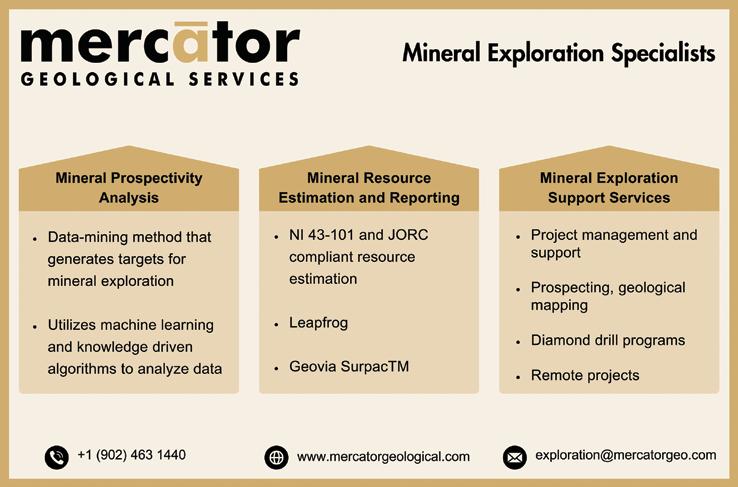

In the early 1970s, while Paul v illgren was working as an industrial technical sales representative specializing in mining supplies and equipment, he noticed a significant gap in the market while he was working in northern Ontario, where very few companies were focused on selling wire rope, chain, and rigging supplies and services. Motivated by this opportunity, v illgren founded Sling-Choker Manufacturing Ltd. in 1975 in Sudbury, Ont., a key mining area. Initially, Sling-Choker produced wire rope slings for the mining and construction industries, and chokers for the forestry sector. Soon, the company expanded to also manufacture nylon and chain slings.
Sling-Choker quickly gained a reputation as a comprehensive source for rigging supplies and solutions, and recognizing the need for more specialized industrial products, the inventory was expanded to include products for the mining and construction industries. As the company continued to grow, the rising demand from out-of-town customers necessitated additional locations. This growth has expanded the company to 14 manufacturing locations across Canada, with a product catalogue now exceeding over 320 pages. Today, Sling-Choker has strategically placed branches in Ontario, Québec, and Manitoba. Each branch boasts manufacturing capabilities and a dedicated sales team, allowing them to
Sling-Choker sets itself apart with exceptional customer service, a wide range of expertise in various product lines, and an understanding that continued success requires investment in its employees.
develop specialized product lines and expertise tailored to the local market needs while leveraging the group’s collective knowledge.
Sling-Choker primarily offers lifting, rigging, and inspection services as a traditional rigging shop. Each branch also focuses on products and services to serve their markets, from products for the cellular tower market, fall arrest repairs and servicing, safety and workplace training, and overhead crane installation and servicing. To better serve its customers, Sling-Choker has formed strategic partnerships with reputable industry brands like Bridon-Bekaert, Crosby, Columbus McKinnon, Apex Tools, Kito, Vulcan, Polydeck, Selene Plastic Bags, Rezplast, and more. These partnerships, along with the ability to produce custom slings, ensure SlingChoker can meet any project’s needs.
“Crane rope designs have become more sophisticated, incorporating multi-strand, compacted, and plastic components, replacing the simpler 6x25 or 6x36 constructions,” explains Kane Butcher, general manager at Sling-Choker (h amilton) Ltd. “We work with our manufacturers to match the right rope to the right application, demonstrating that operational cost savings can often be more economical than upfront costs.”
Despite the rise in online sales of rigging products, SlingChoker sets itself apart with exceptional customer service, a wide range of expertise in various product lines, and an understanding that continued success requires investment in its employees.
Butcher emphasizes the importance of recognizing every team member’s value in contributing to Sling-Choker’s success.
“By working as a team, we can provide outstanding quality and service, and we greatly appreciate the positive feedback from our customers,” says Butcher.
Reflecting on nearly five decades of service, Butcher nostalgically recalls the early days of the company.
Sling-Choker has strategically placed branches in Ontario, Québec, and Manitoba. Each branch boasts manufacturing capabilities and a dedicated sales team.
“Back then, companies had ample staff, allowing for strong customer relationships and loyalty. Today, with minimal staff and an influx of inconsistent imported products, multitasking is the norm,” he says. “While we offer global products, we select them based on quality and suitability.”
Sling-Choker holds the distinction of being the longest-serving member of the Web Sling and Tie Down Association (WSTDA) for 45 years. The company values its membership, appreciating WSTDA’s role in setting industry standards.
“The WSTDA brings together resources from all stakeholders to develop the standards we rely on as an industry,” says Butcher. “By adhering to these standards for raw materials, threads, and finished products, we ensure market safety.”
Looking ahead as Sling-Choker celebrates their 50th anniversary in 2025, they plan to continue their growth and adapt to evolving market conditions while sharing its quality and expertise with customers. 8




Kovatera Inc., a privately owned Canadian corporation headquartered in Sudbury, Ont., central to Canada’s underground mining sector, specializes in the design and manufacture of versatile mining utility vehicles. Renowned for enhancing safety and productivity, Kovatera prides itself on comprehensive after-sales service and customer support. Its dedicated engineering department collaborates closely with clients, offering tailored solutions and continually refining products to maximize customer profitability.
Established in 1999, Kovatera has expanded significantly and relocated to a state-of-the-art 35,000-squarefoot manufacturing facility in 2012. Today, the brand is synonymous with innovation in the underground mining industry, particularly across Canada and key global markets.
Kovatera currently offers two main product lines:
• KT Series Vehicles: Heavy-duty underground trucks on a 13,000-lb. platform.
• KM Series Vehicles: Versatile utility vehicles resembling heavy-duty tractors, serving as Kovatera’s flagship product.
In addition to serving Eastern Manitoba and Ontario, Kovatera distributes and supports its products through an extensive dealer network spanning India, Australia, the USA, Western Canada, Québec, Mexico, Indonesia, Sweden, and Turkey.
Kovatera is proud to unveil its latest innovation, the Battery Electric vehicle (BE v ) model line, at MINExpo 2024. These cutting-edge BE v models promise to revolutionize the mining industry with their advanced technology and commitment to sustainability. They offer superior performance, efficiency, and environmental benefits, setting a new standard for mining equipment globally.
BE vs provide several advantages over traditional diesel equipment, including zero emissions, which significantly improve air quality and safety in confined spaces. They operate quietly and with reduced heat generation, creating a more conducive and productive work environment.
This initiative underscores Kovatera’s dedication to sustainable practices and responsible resource extraction. It aims to establish new benchmarks in eco-friendly mining solutions. Each BE v model can be customized to match its diesel counterparts in functionality, ensuring seamless integration into existing mining operations.
Kovatera invited mining companies, industry professionals, and experts to join them at MINExpo 2024 in Las vegas this past September, where the company showcased the KT300e and its revolutionary BE v lineup.
They look forward to welcoming you and demonstrating their commitment to innovation and the advancement of underground mining.


for more information, visit www. kovatera.com or connect on LinkedIn. for media inquiries or to schedule a meeting, please contact:
Contact information: Don King, Sales & Marketing Manager dking@kovatera.com
Will g ove, g eneral Manager wgove@kovatera.com 8











